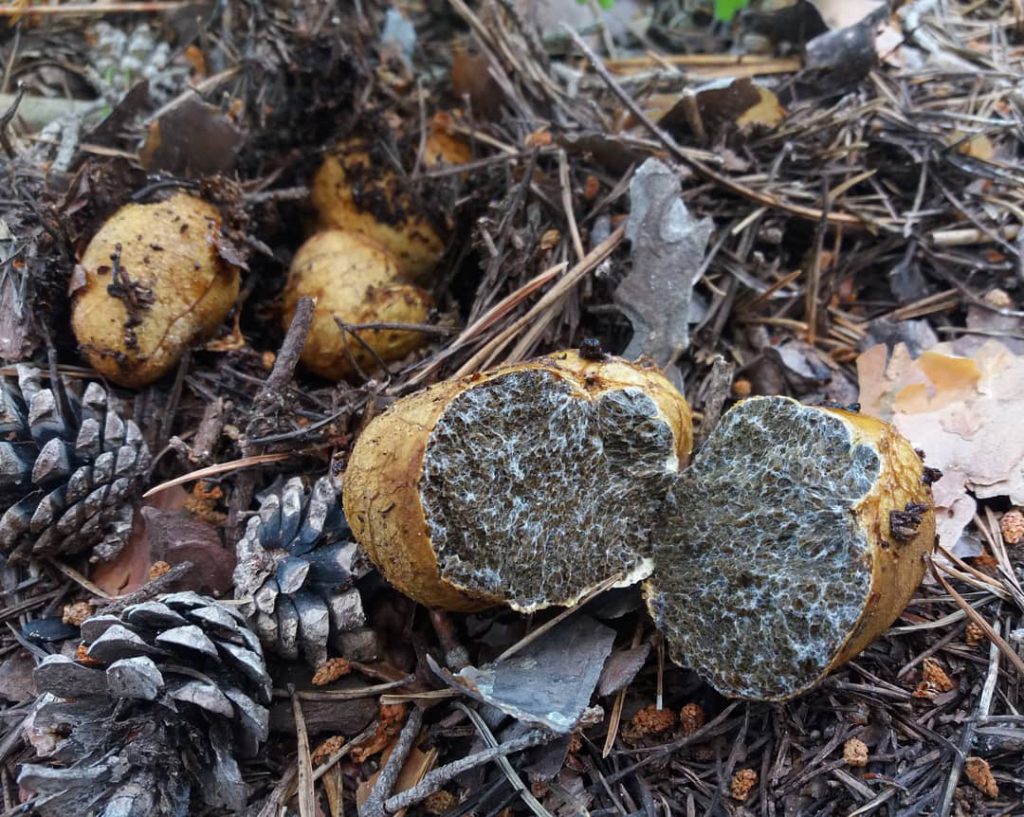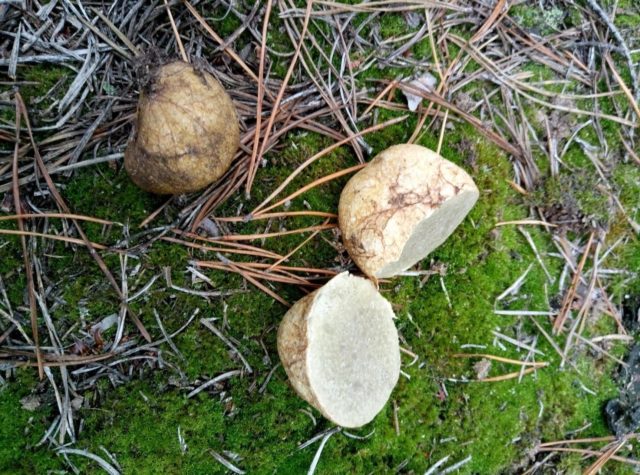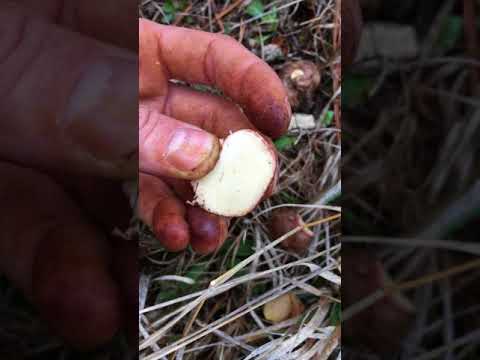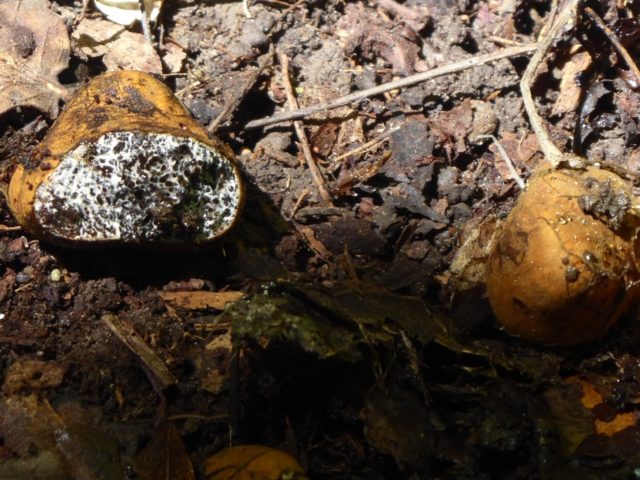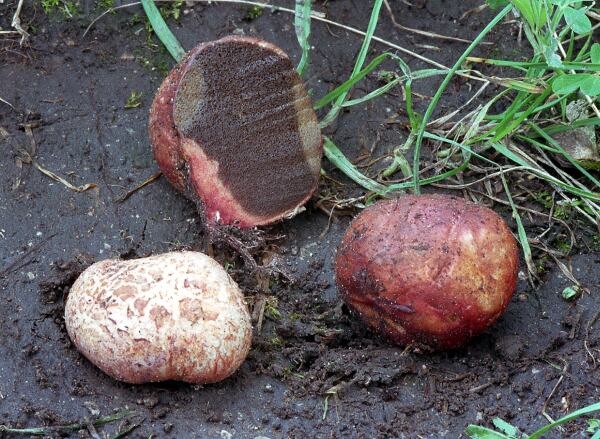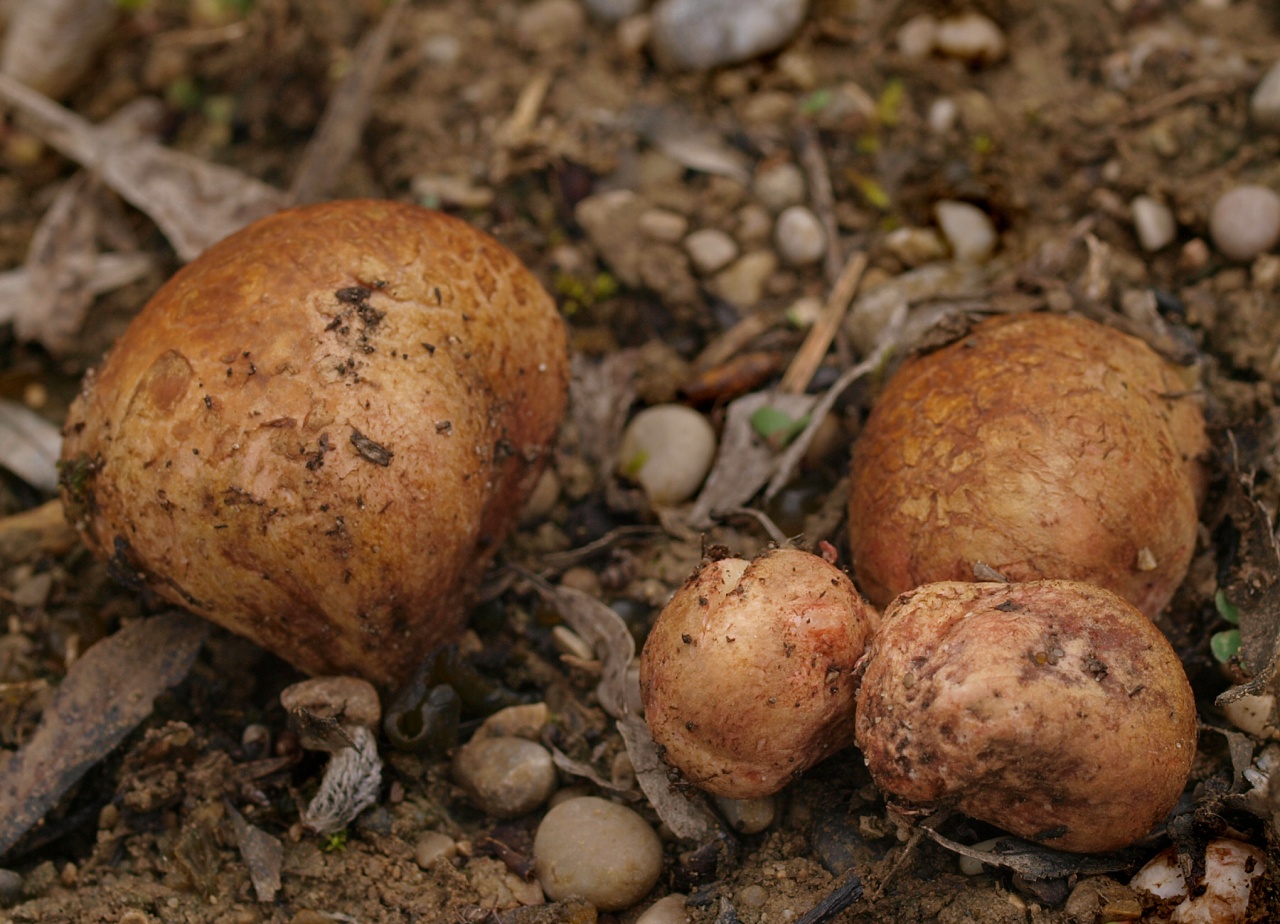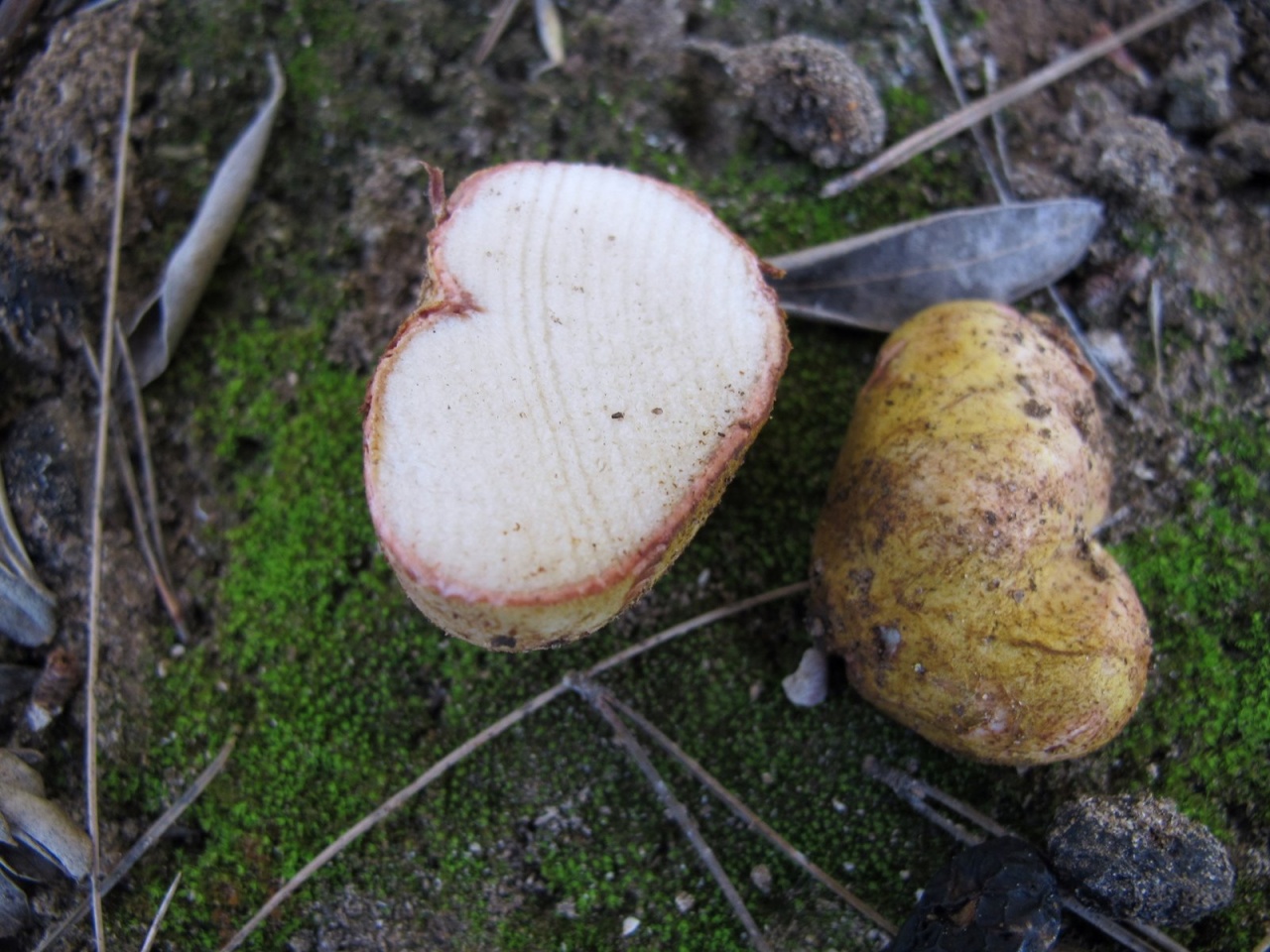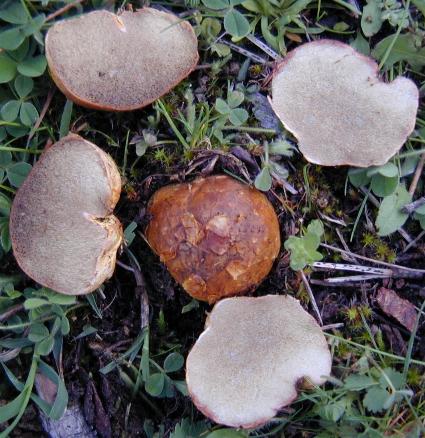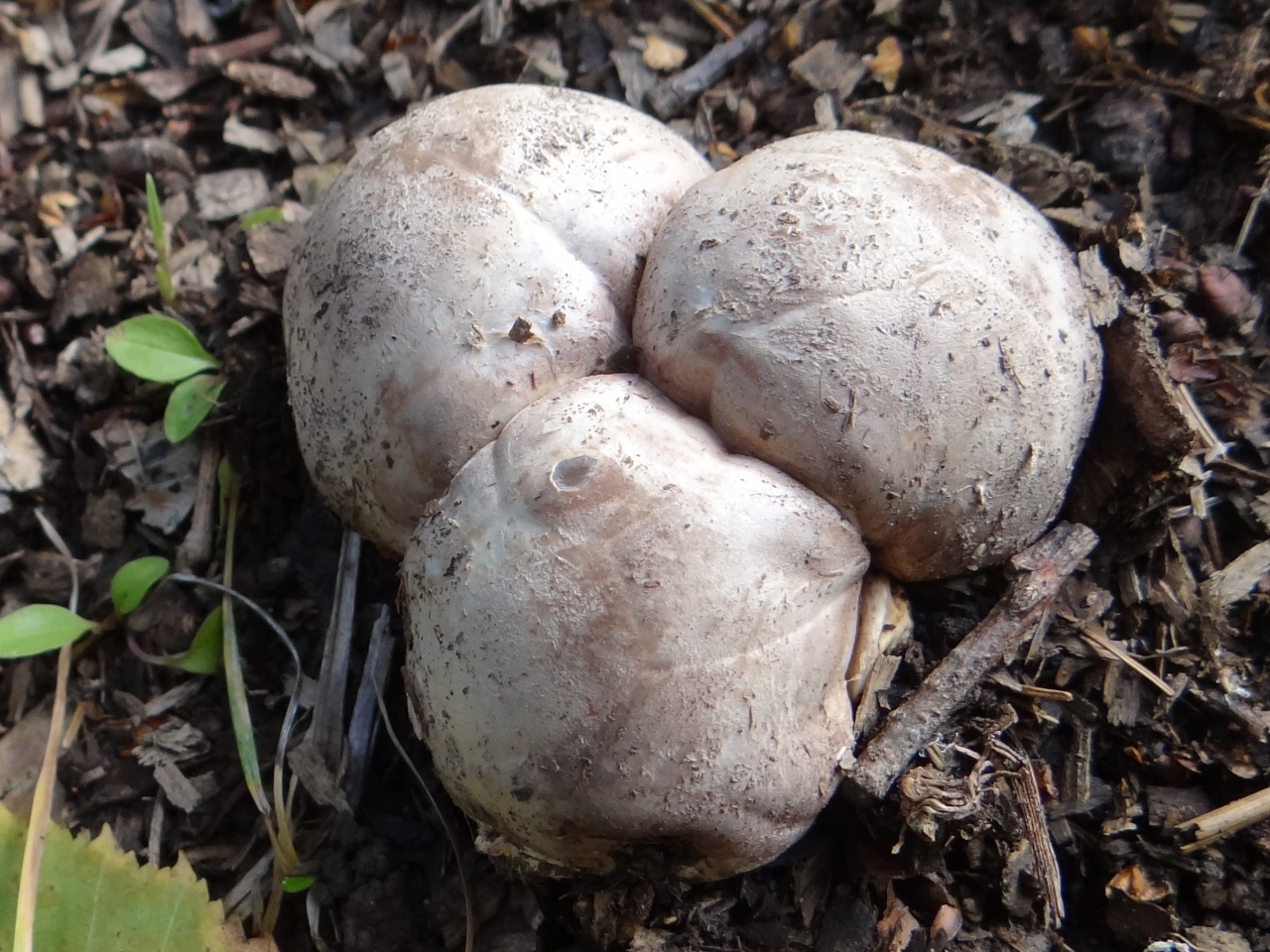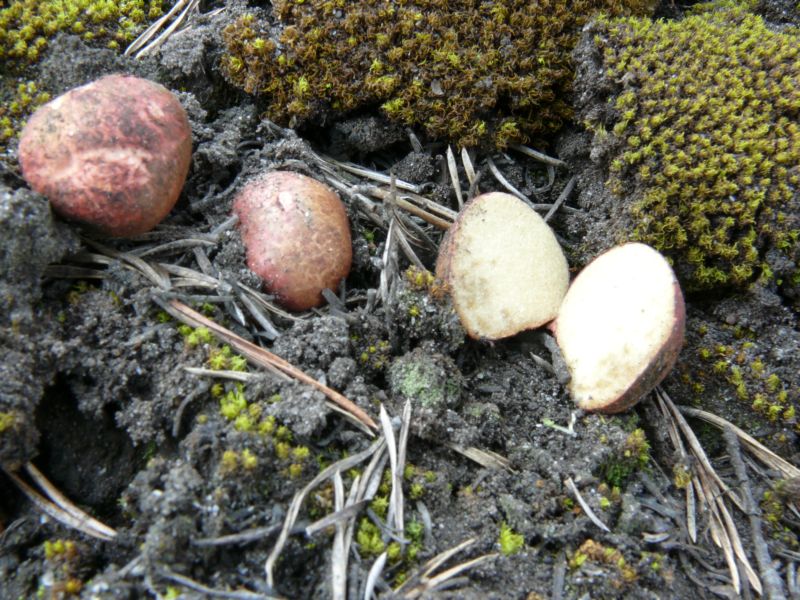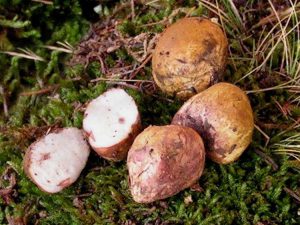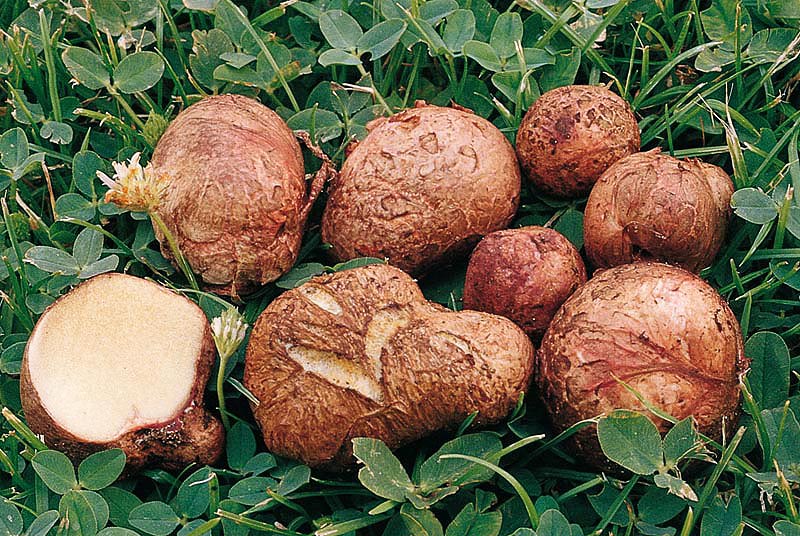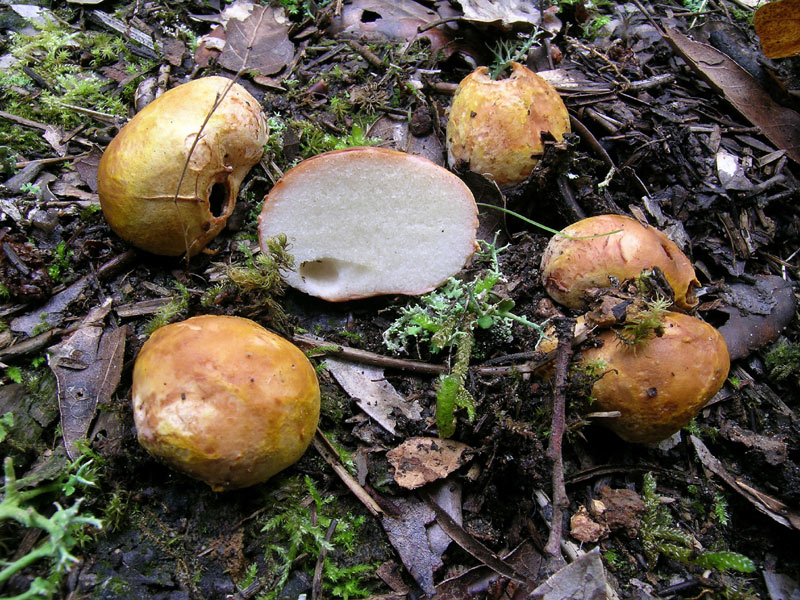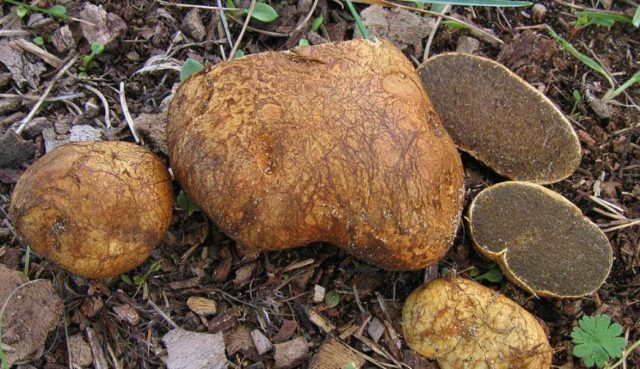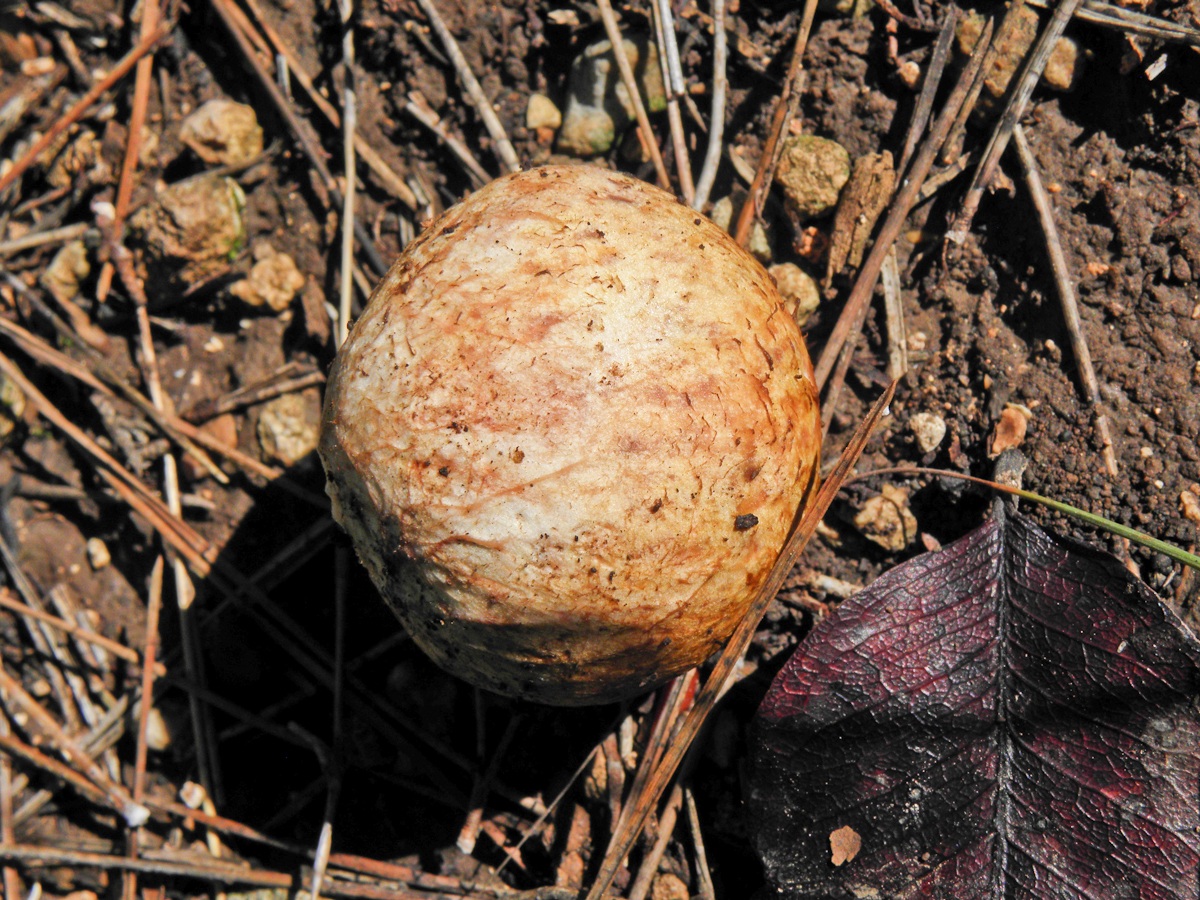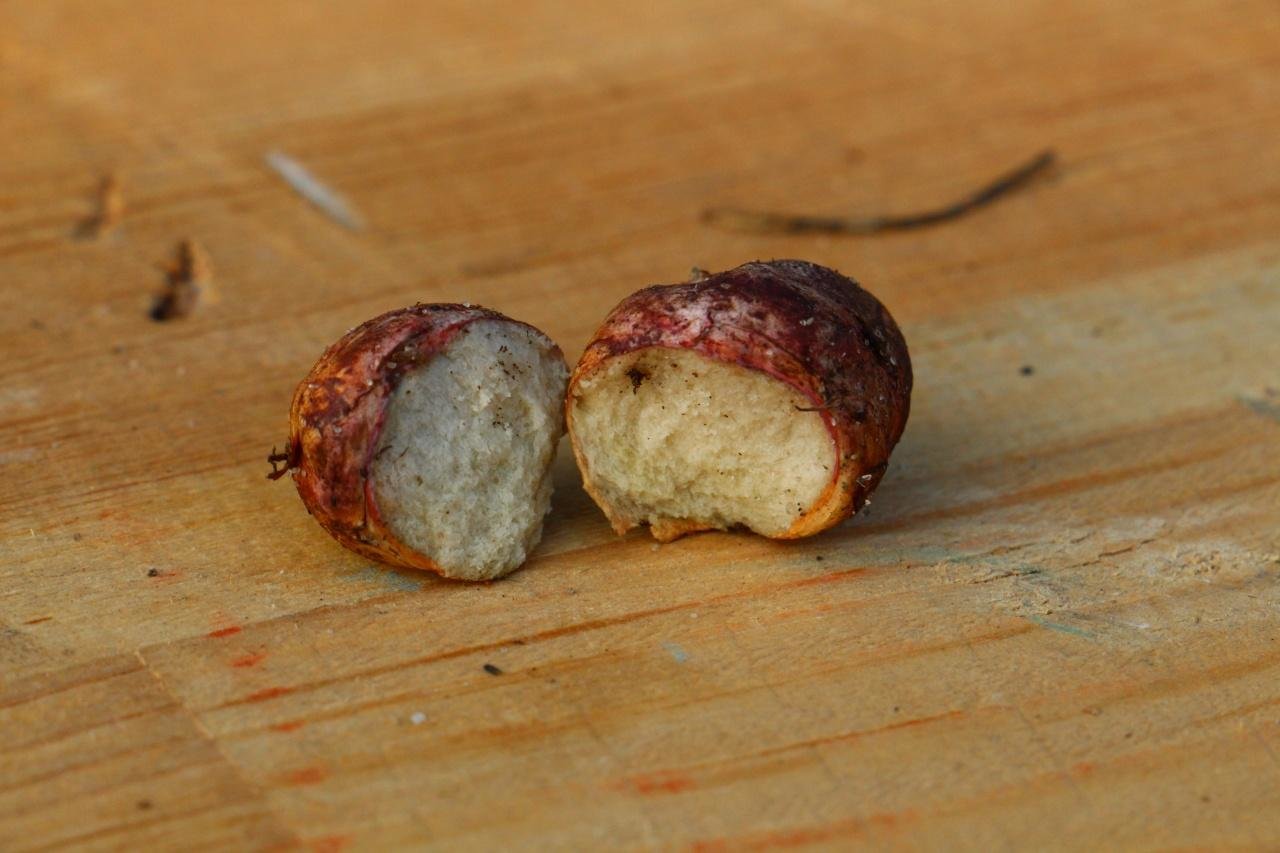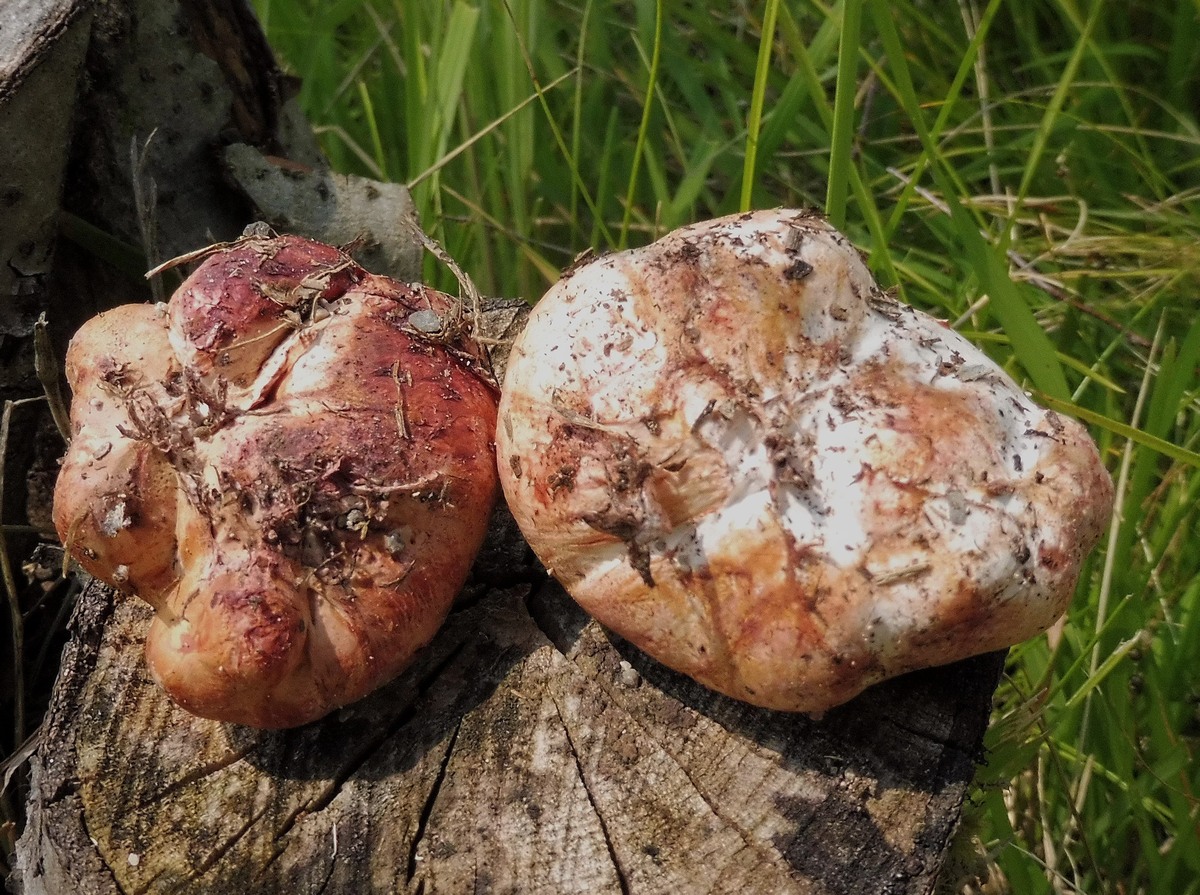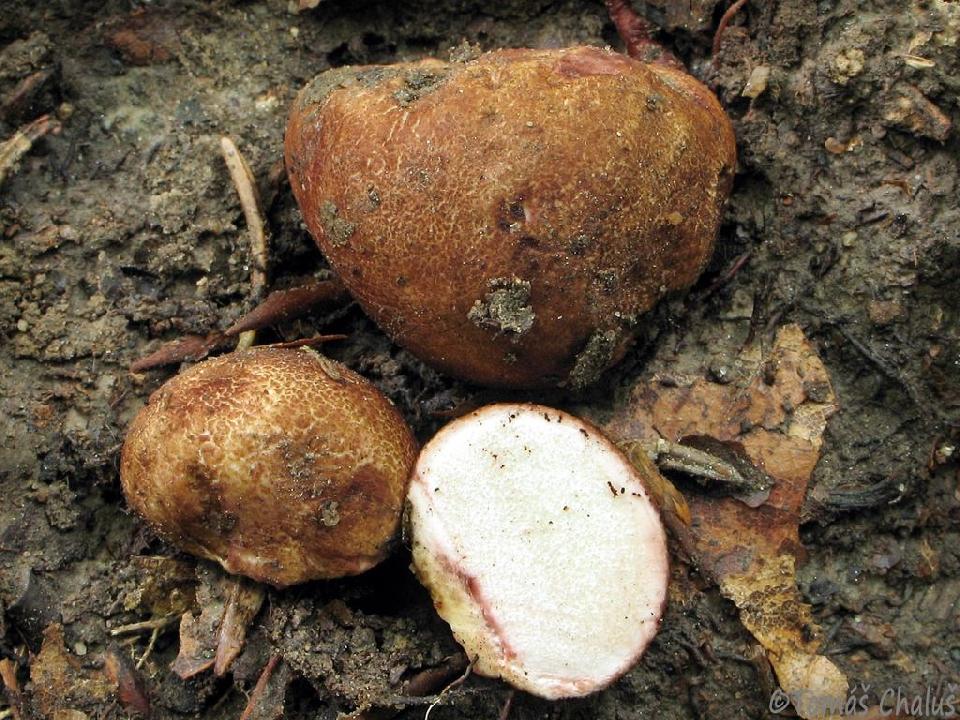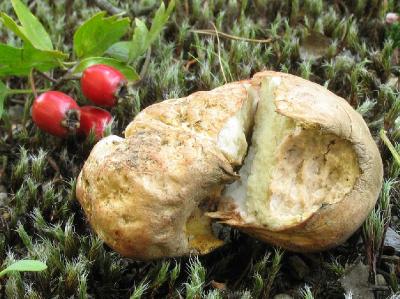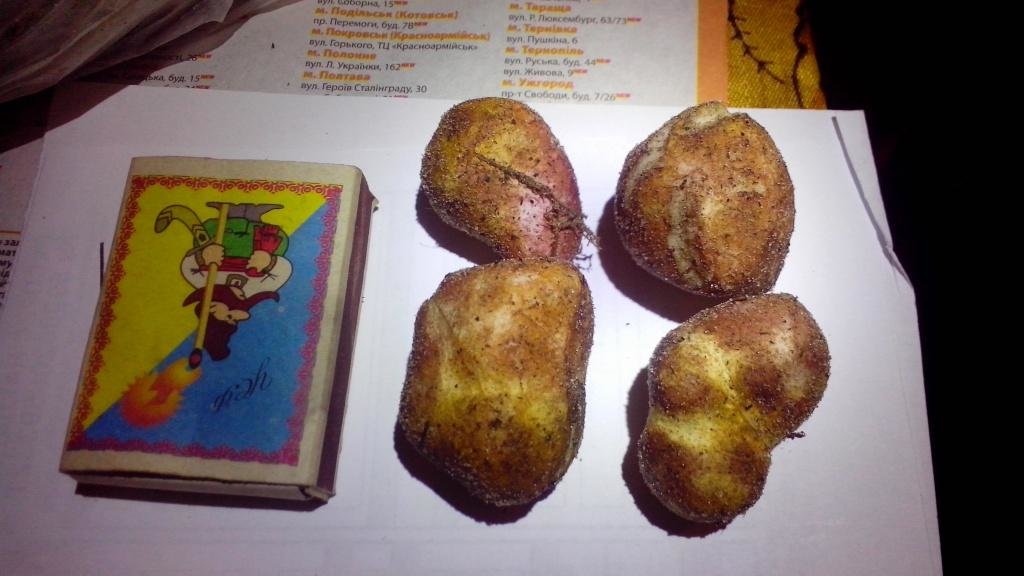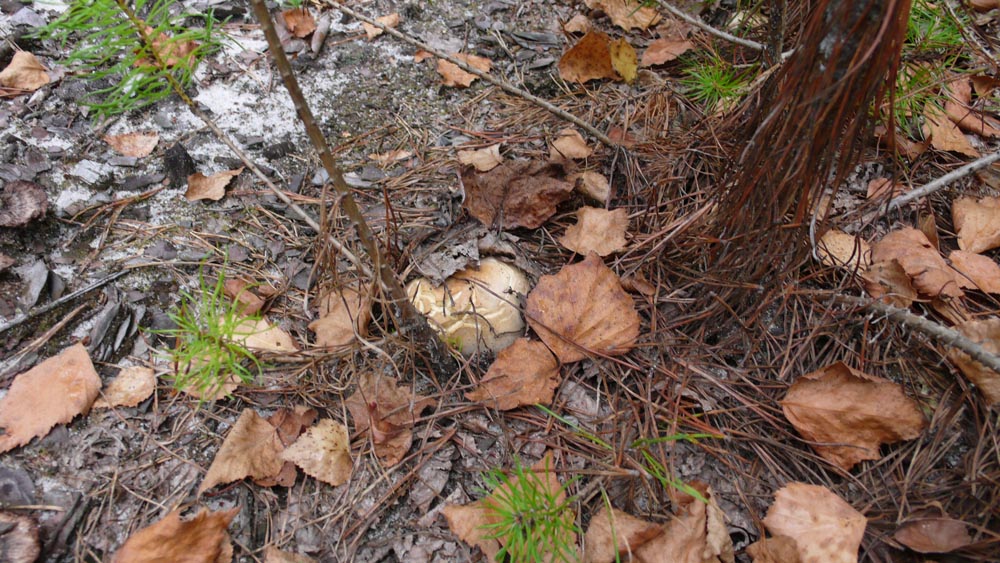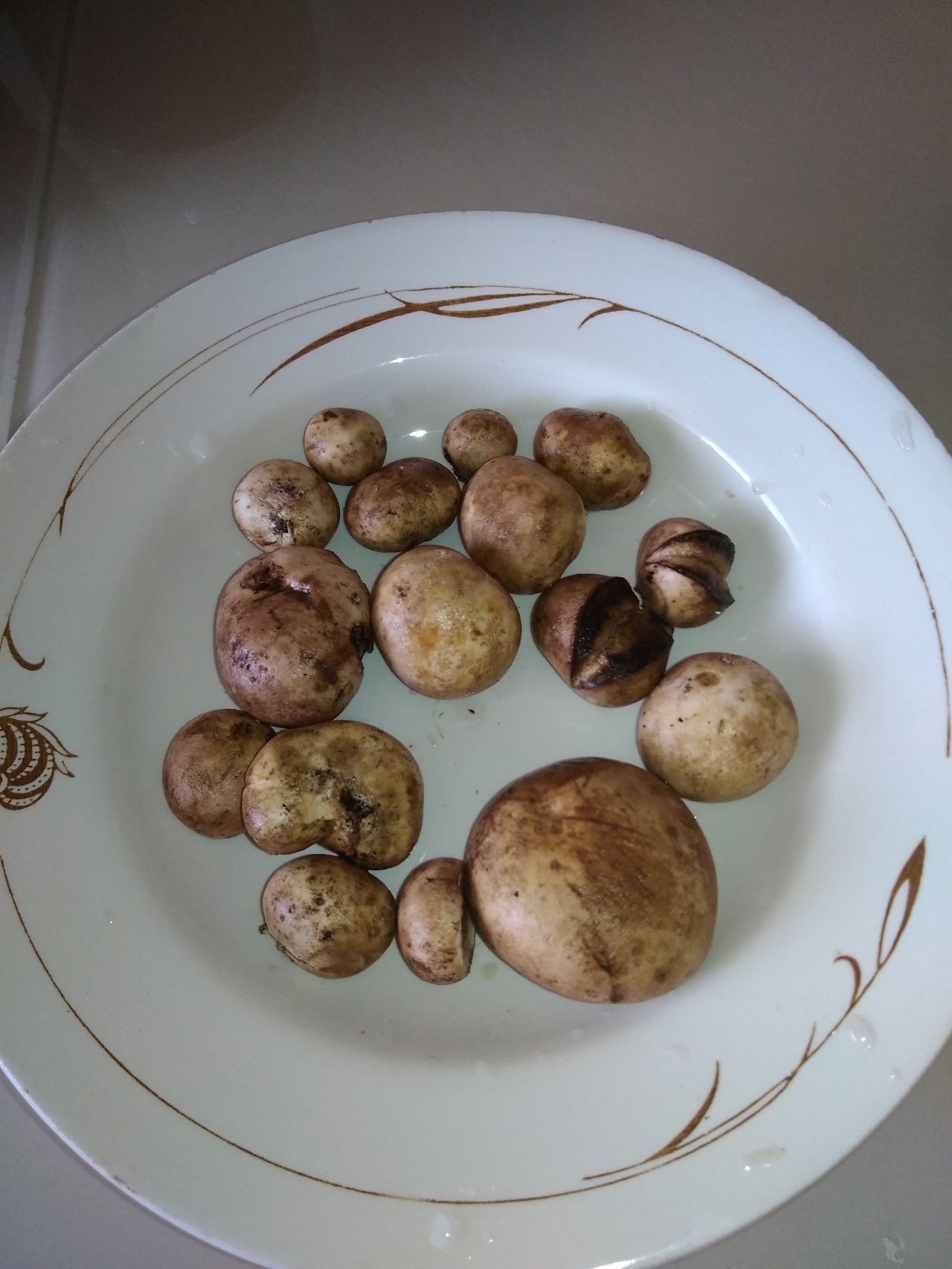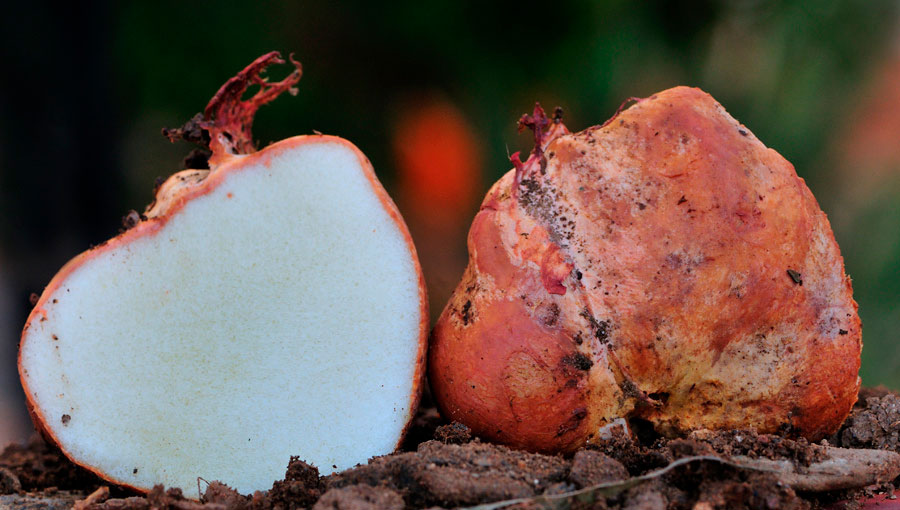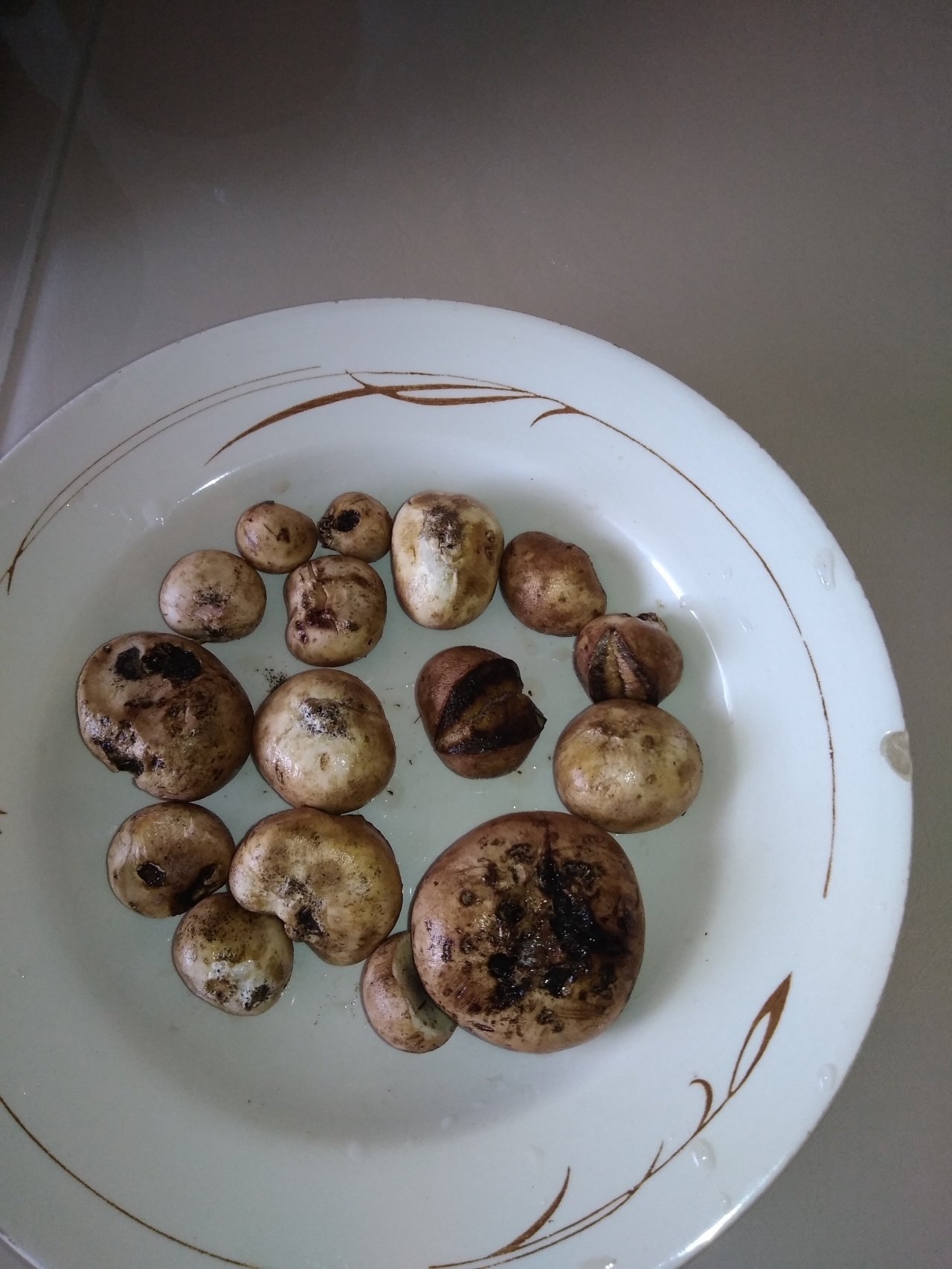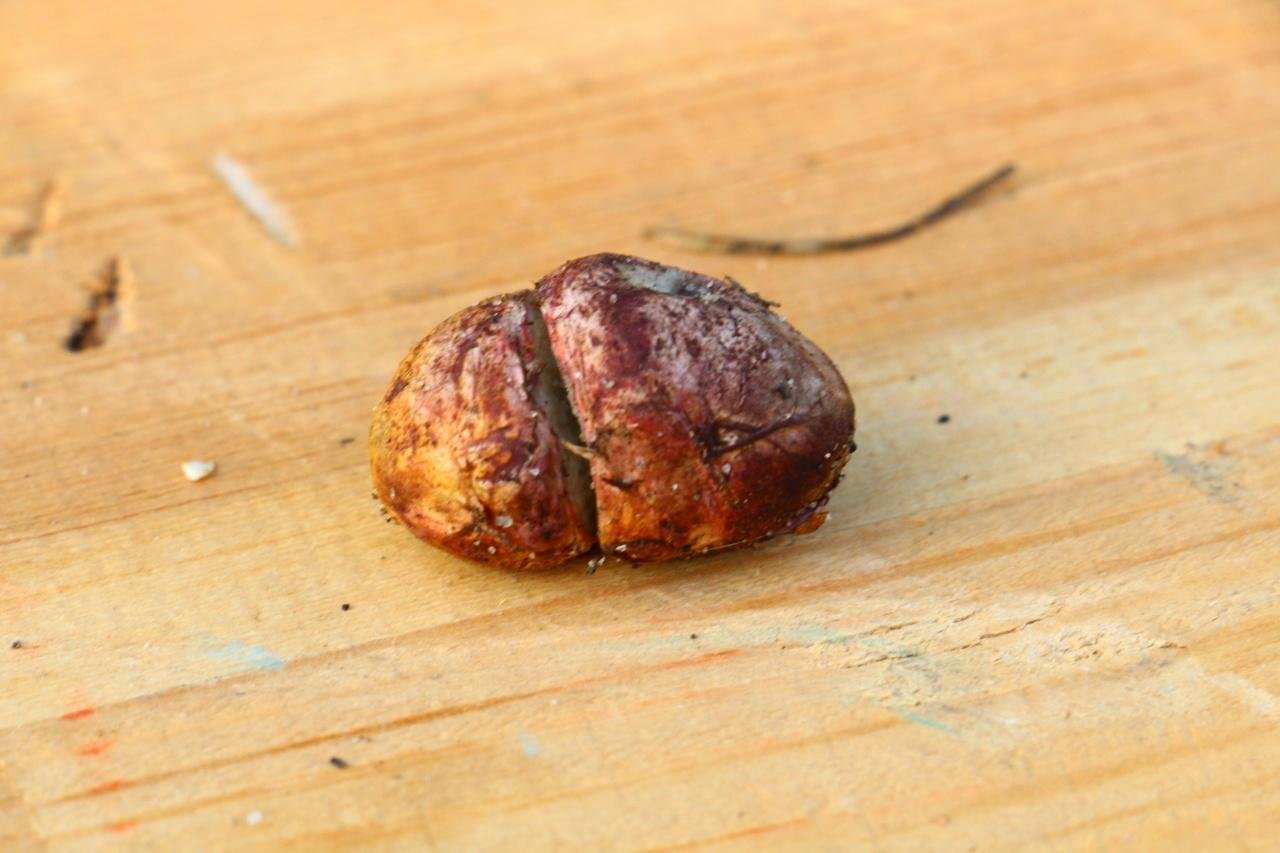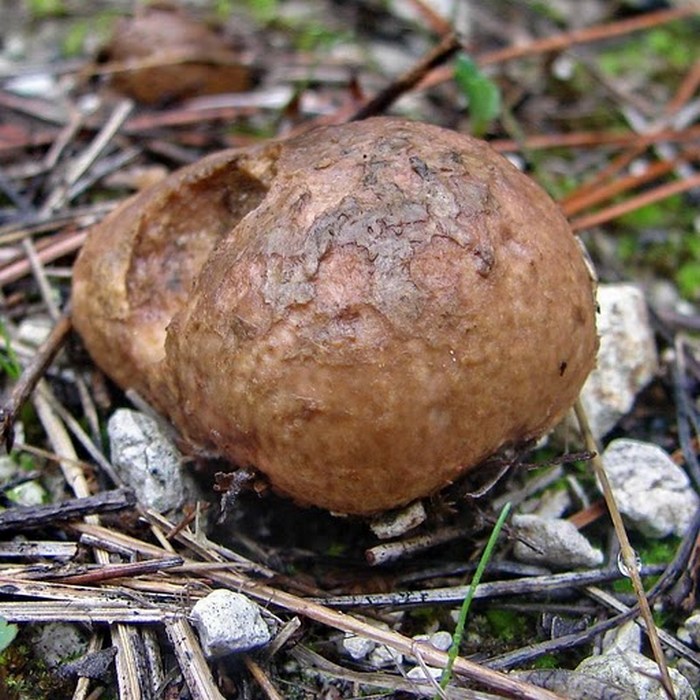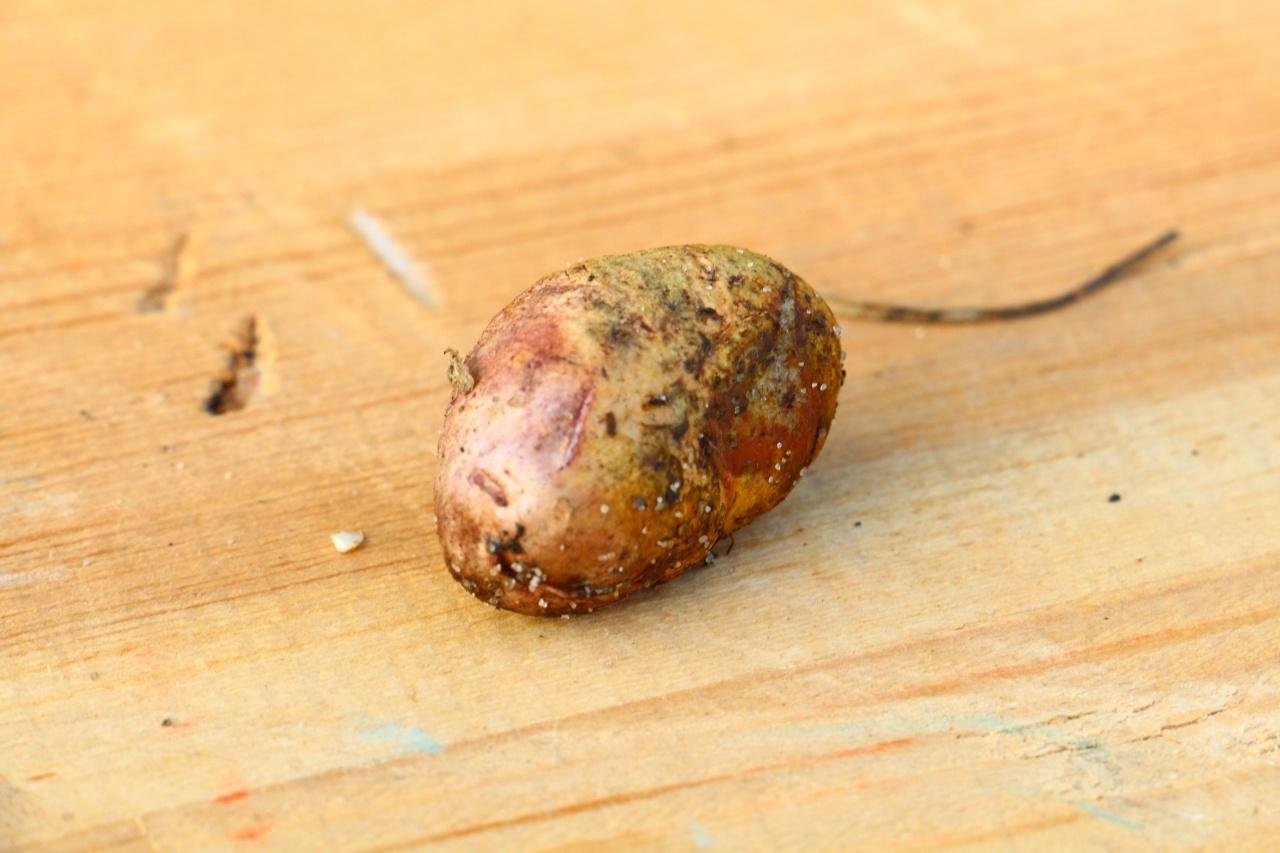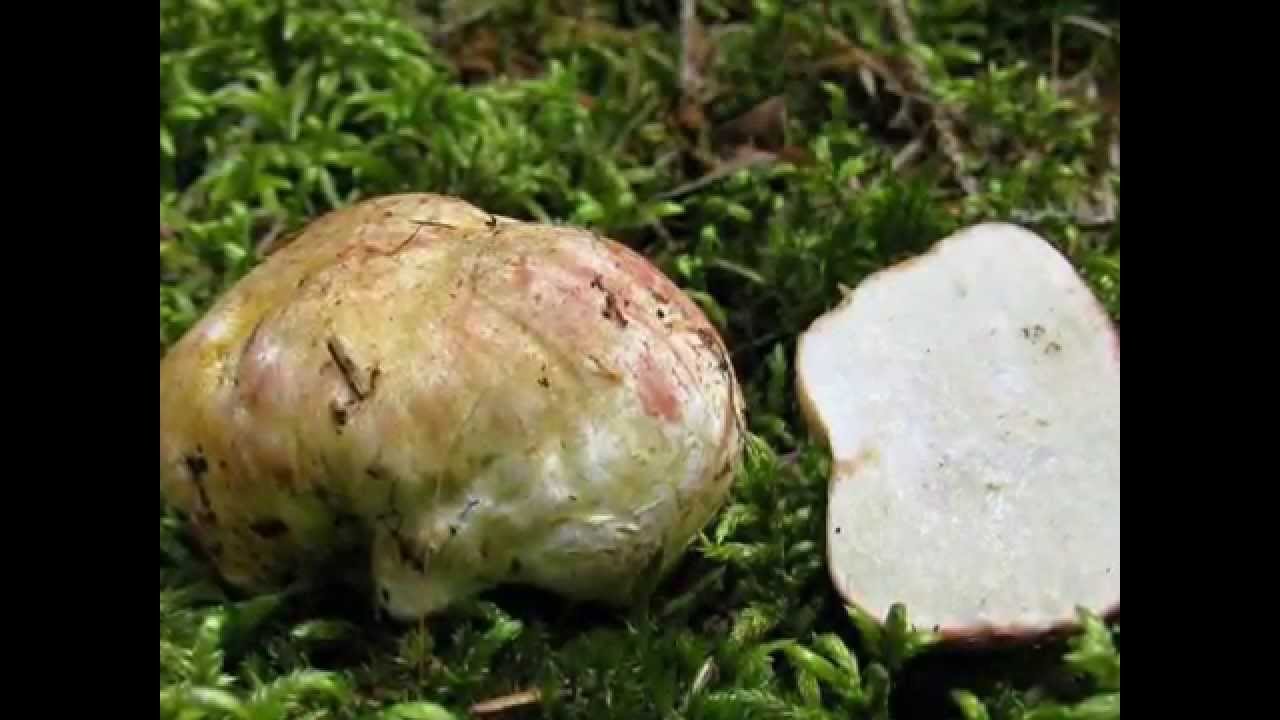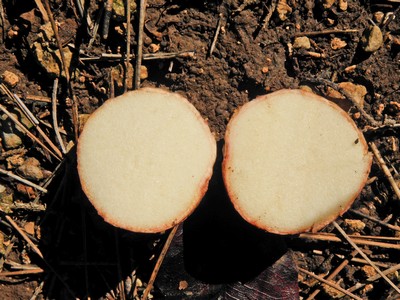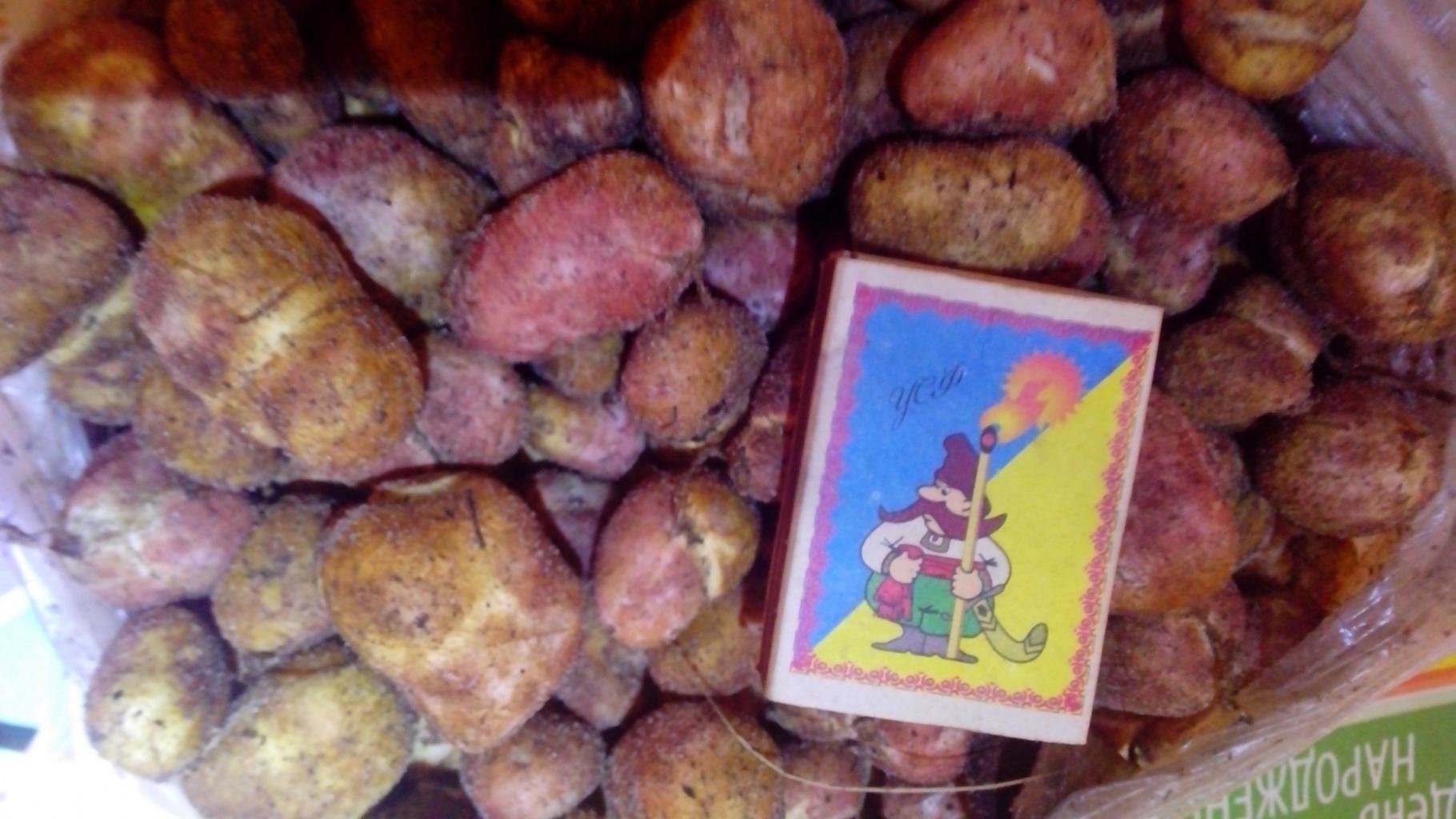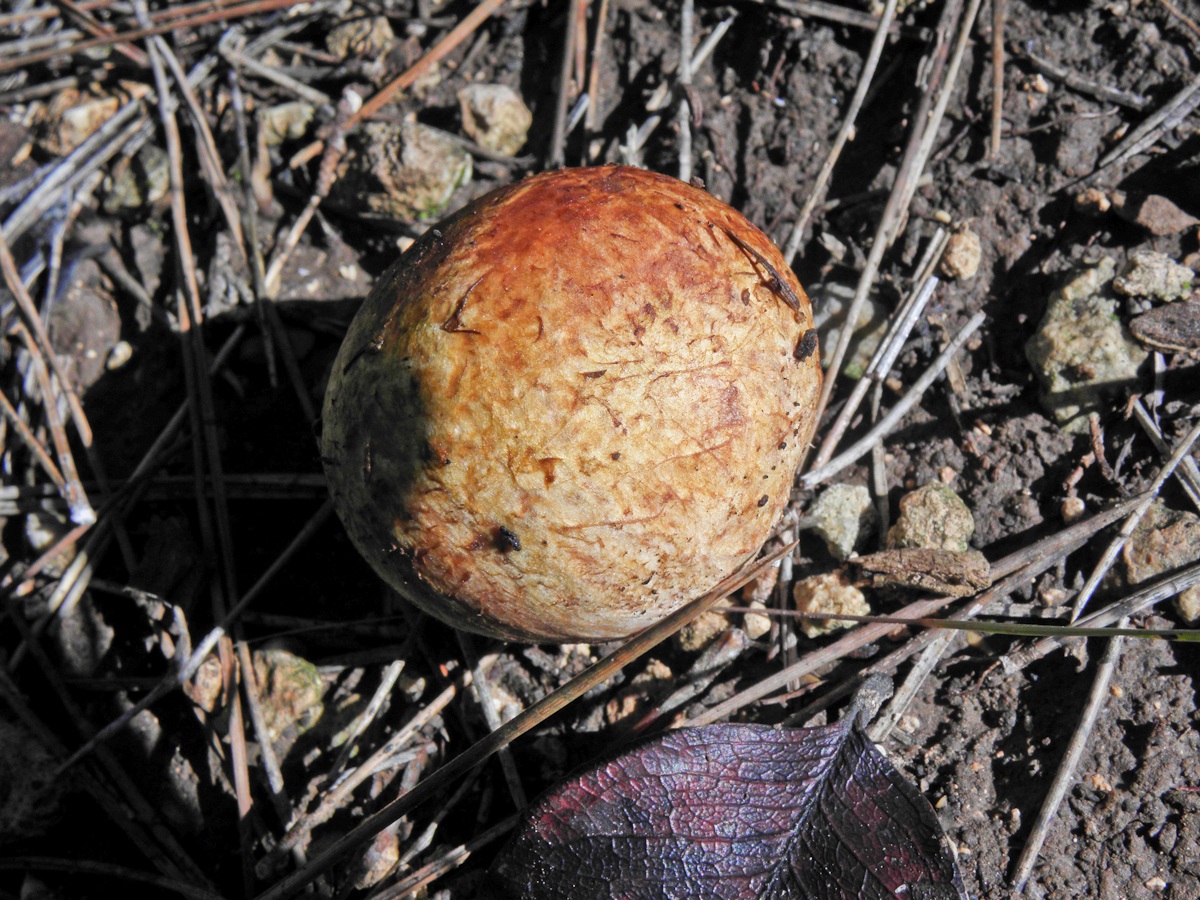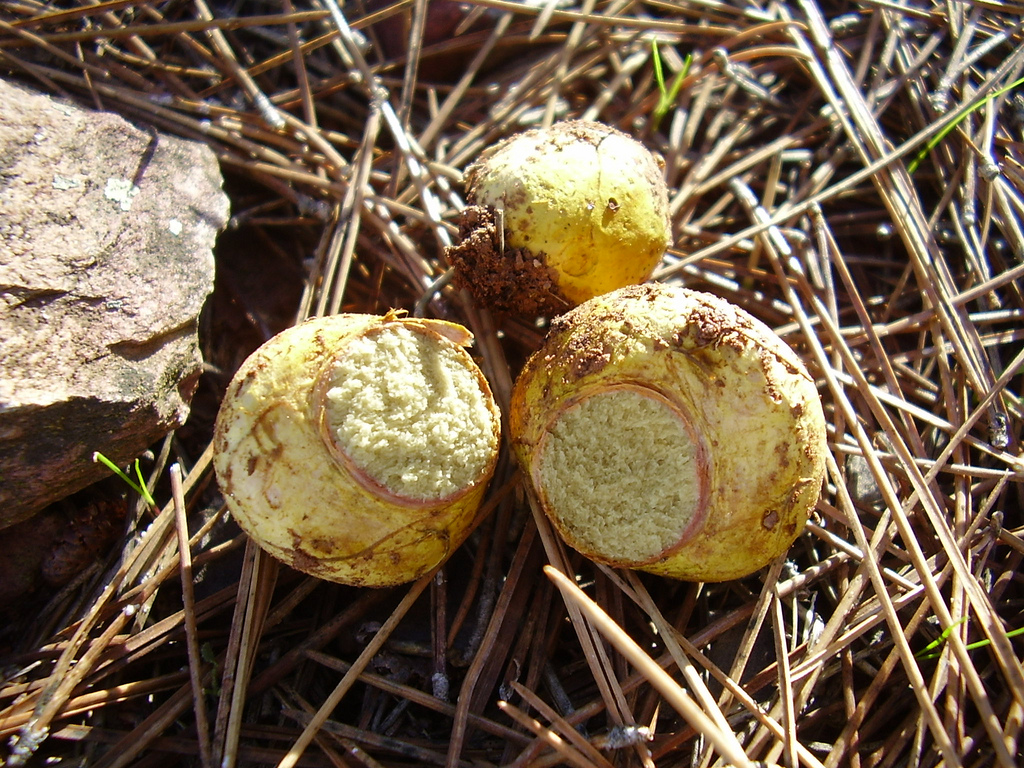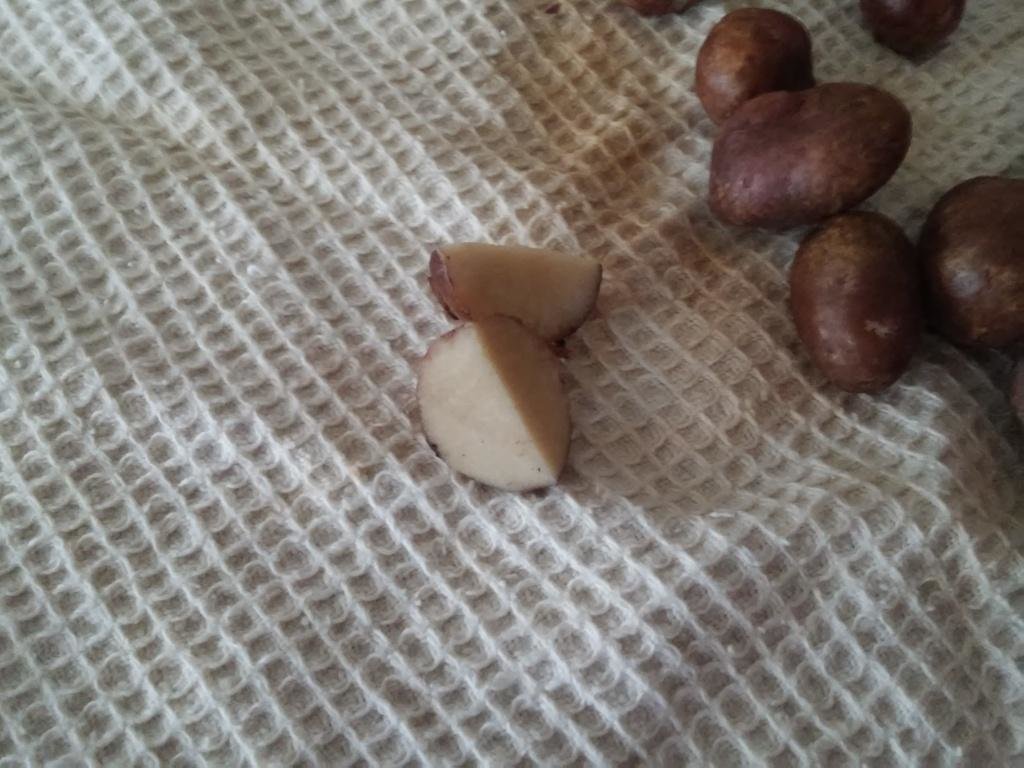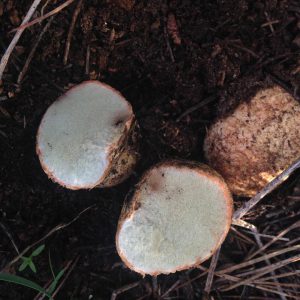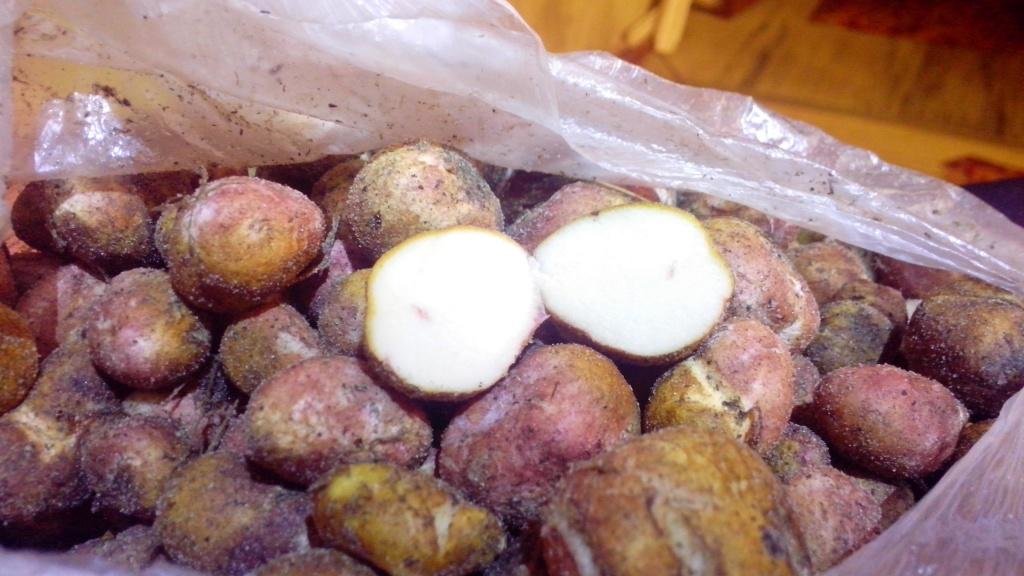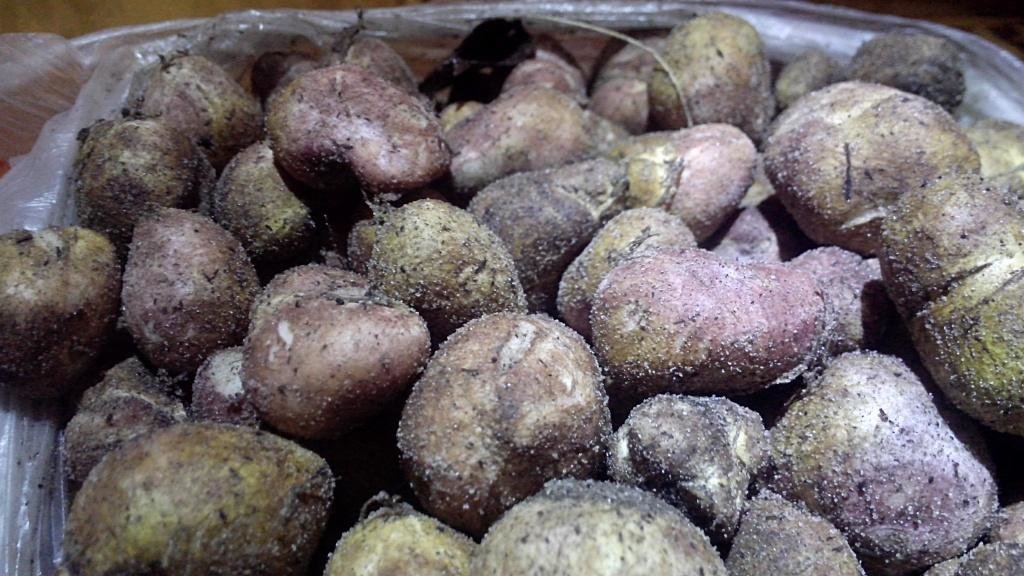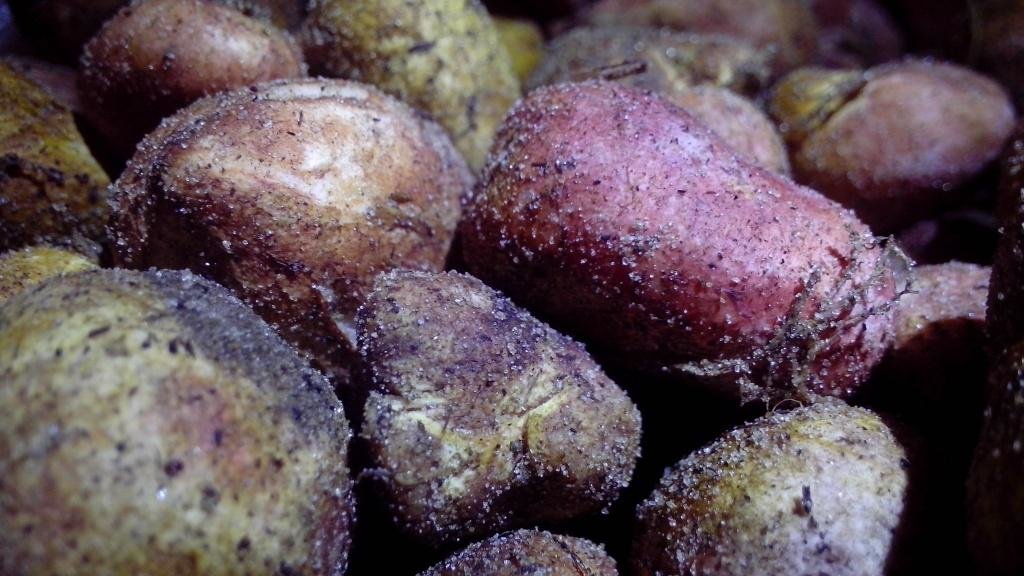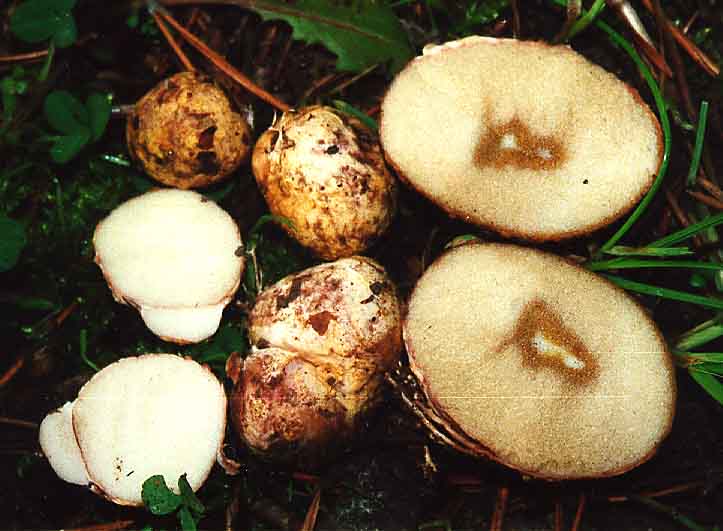Rizopogon
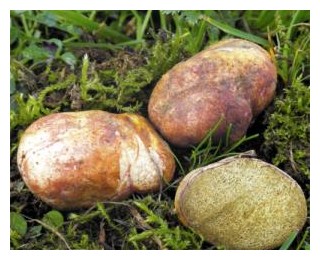
Rhizopogon pinkish can be found only occasionally, since this mushroom tends to develop half underground. The fruiting body is up to 1-4 cm in diameter, irregularly spherical or tuberous, at an early age whitish, velvety, after naked and yellowish, in the air and upon damage acquire a reddish-pink or red-brownish color, hard, with whitish "roots" (rhizomorphs) below. The inside is yellow-olive, oily yellow, or light greenish, with thin, small, curved chambers. The pulp has a fruity smell. Spores are smooth, light lemon-yellow, elliptical, 8.4-11 x 3.60-4.5 microns.
In summer it occurs quite often and in autumn during the period (June - October) mainly in mixed and deciduous and coniferous forests, most often under spruces and pines, but also under oaks and other trees.
The mushroom is edible.
Rhizopogon pinkish is very similar to the common rhizopogon (Rhizopogon vulgaris), which is distinguished by a gray-brown color of non-reddening fruit bodies
RIZOPOGON YELLOW, YELLOW ROOT RHIZOPOGON OBTECTUS

Rhizopogon is a yellowish, yellowish rootstock of Rhizopogon obtectus (Rhizopogonluteolus).
Fruit body: yellowish tuberous rhizopogon, oblong, about the size of a walnut, part of the fruit body goes into the ground, the outer layer is cork-hard, brown-leathery closer to youth, dirty brown in old age, entwined with thin brown hyphae from the lower part. The outer layer has a fine sinuous pattern and a garlic smell
Season and place: Yellowish Rhizopogon grows in autumn and summer in pine forests on sandy soil. Very often only the top can be seen from the ground.
Similarity: The mushroom is tasteless. Try not to confuse this mushroom with poisonous species.
Red trellis mushroom
The red trellis mushroom or, as it is also called, the red clathrus is listed in the Red Book and is the only representative of the trellis family. Found in Russia mainly in ...
Mushroom netnose. In young mushrooms, the fruit body has an ovoid shape, sometimes cylindrical white or yellowish-white in color with a diameter of up to five centimeters. When the fruit body of the mushroom is set ...
Ethnomycology
Forestry
The first intentional use of Rhizopogon species in forestry occurred in the early part of the 20th century when Rhizopogon luteolus was deliberately introduced into Pinus radiata plantations in Western Australia after it was observed to improve tree growth. Since that time, Rhizopogon species have been widely studied as a component of managed forests. Rhizopogon species have been noted as common members of the ectomycorrhizal community colonizing tree roots of pine and Douglas-fir timber plantations. Naturally occurring Rhizopogon roseolus (= rubescens) spores have been shown to out-compete the spores of other ectomycorrhizal fungi in pine plantations even when competing spores were directly inoculated onto seedlings. The survival rate and performance of pine and Douglas-fir plantation seedlings are increased after inoculation with Rhizopogon species.
Gastronomy
Though many species of Rhizopogon are considered edible, most are not held in high culinary esteem. A notable exception is Rhizopogon roseolus (= rubescens) which is considered a delicacy in east Asia and especially in Japan where it is traditionally known as Shoro. Techniques for the commercial cultivation of this fungus in pine plantations have been developed and applied with successful results in Japan and New Zealand.
False doubles
In appearance, common Rhizopogon is similar to the very rare Melanogaster ambiguus, a gasteromycete of the Pig family. Its fruiting body is represented not by a cap and a leg, but by an integral gastrocarp with a dense shell and a fruiting gleba. The surface of the mushroom is at first dull and velvety, colored in a gray-brown scale. As it matures, the peridium takes on a yellow-olive color with dark brown spots that resemble bruises. Old mushrooms are black-brown with a whitish coating.
Inside, the young melanogaster is whitish with blue-black chambers; in adulthood, the flesh darkens significantly, becoming red-brown or black with whitish veins. At the beginning of growth, the mushroom exudes a pleasant sweetish fruity aroma, but over time it is replaced by the fetid smell of dying onions or rubber. Information about the possibility of use is contradictory: some experts consider the mushroom edible at a young age, while others refer to the inedible species.
It is not surprising that common Rhizopogon is similar to other fungi of the genus Rhizopogon, in particular, yellowish Rhizopogon (Rhizopogon luteolus). The fungus is widespread in the temperate zone and in the north of Eurasia; it prefers light sandy soils of pine forests.
The surface of the fruit body at a young age is painted in a whitish-olive or light brown color, later darkens to brown-brown and cracks. The skin is entangled with brown-gray filaments of mycelium. The pulp is initially yellowish-white, with age it changes color to yellow-olive or greenish-brown. Old mushrooms are almost black inside. Rhizopogon yellowish is considered a conditionally edible product with low taste, when fried it looks like a raincoat.
Another double of the common rhizopogon is the pinkish rhizopogon (Rhizopogon roseolus), also called the pinkish or reddening truffle. The species is distinguished by a yellowish skin, which, when pressed, turns pink, like the flesh when cut or broken. The places and season of growth of the pinking truffle are identical to the common rhizopogon. The species is conditionally edible.
According to external data, common rhizopogon can be confused with an edible white truffle. The valuable counterpart also has a brownish color and tuberous shape, but it is more sinuous and coarse.
Ecology
A sporocarp of Rhizopogon roseolus in cross section showing a close up of the gleba locules
Mammalian diet and spore dispersal
Rhizopogon species have been established as a common component in the diet of many small mammals as well as deer in Western North America. The viability of Rhizopogon spores is maintained and may even be increased after mammalian gut passage, making mammals an important dispersal vector for Rhizopogon.
Disturbance ecology
Rhizopogon species are common members of the fungal communities that colonize the roots of trees during seedling establishment and persist into old growth stands.Rhizopogon spores are long lived in soil and the spores of some species can persist for at least four years with an increase in viability over time.Rhizopogon seems to be especially common upon the roots of establishing tree seedlings following disturbance such as fire or logging.Rhizopogon are also abundant colonizers of pot cultivated and field cultivated conifer seedlings growing in soil from conifer stands that lacked observations of Rhizopogon upon the roots of mature trees. These finding suggest that Rhizopogon species are an important factor in the recovery of conifer forests following disturbance.
Invasive facilitator
Rhizopogon species have been shown to have a global distribution in the Homogenocene. The enzymes exuded from some species within the subgenus amylopogon is essential in activating seed germination in some species of Monotropoideae, such as Pterspora andromedeae ... This makes Rhizopogon an obligatory host to species like P. andromedeae. The exoenzymatic activity also confers higher competitive advantages to host species, mainly within the genus Pinus, by helping to break down nutrients within the soil. The presence of Rhizopogon in soil facilitates Pinus as an invasive species. This exoenzymatic activity is nitrogen limited. In the case of R. amylopogon parasitized by P. andromedeae the nitrogen cost of exoenzymatic production is in part paid for by bacteria within the family Burkholderiaceae that is hosted by P. andromedeae
Species
- Rhizopogon albidus
- Rhizopogon ater
- Rhizopogon amylopogon
- Rhizopogon atroviolaceus
- Rhizopogon brunneniger
- Rhizopogon ellenae
- Rhizopogon evadens
- Rhizopogon fulvigleba
- Rhizopogon fuscorubens
- Rhizopogon hawkerae
- Rhizopogon luteolus
- Rhizopogon nigrescens
- Rhizopogon occidentalis
- Rhizopogon ochraceorubens
- Rhizopogon parksii
- Rhizopogon parvisporus
- Rhizopogon pedicellus
- Rhizopogon roseolus
- Rhizopogon salebrosus
- Rhizopogon subareolatus
- Rhizopogon subaustralis
- Rhizopogon subcaerulescens
- Rhizopogon subpurpurascens
- Rhizopogon subsalmonius
- Rhizopogon succosus
- Rhizopogon togasawariana
- Rhizopogon truncatus
- Rhizopogon vesiculosus
- Rhizopogon villosulus
- Rhizopogon vinicolor
- Rhizopogon vulgaris
Rizopogon yellowish

Rhizopogon yellowish (Rhizopogon obtectus)
- Yellowish root plant
- Rhizopogon luteolus
Rizopogon yellowish or Root plant yellowish belongs to saprophytic fungi, belongs to the family of raincoat fungi. This is an excellent "conspirator", since it is difficult to notice it - almost all of its fruiting body is underground and can only be seen slightly above the surface.
There have been cases when various scammers tried to pass off this mushroom as a white truffle.
The fruit body is tuberous, underground, outwardly similar to young potatoes, with a diameter of 1 to 5 centimeters. Its surface is dry, in mature specimens the skin is cracked, has a color from yellow-brown to brown (in old mushrooms); covered from above with branched brown-black filaments of mycelium. The peel has a specific garlic odor, but it can be removed well under a stream of water with increased friction. The pulp is dense, thick, fleshy, at first white with an olive tint, later brown-green, in mature specimens it is almost black, without a pronounced taste and aroma. Spores are smooth, shiny, almost colorless, ellipsoidal with slight asymmetry, 7-8 X 2-3 microns.
It grows from early July to late September on sandy and sub-sandy soils (for example, on paths) in pine forests. Massively bears fruit at the end of the warm season. The mushroom is little known to most mushroom pickers. Grows in nitrogen-rich soils. Prefers pine forests.
The yellowish root can be confused with the dubious melanogaster (Melanogaster ambiguus), although it is not common in our forests. Yellowish Rizopogon is similar to pinkish Rizopogon (Red Truffle), from which it differs in skin color, and the flesh of the second, when interacting with air, quickly turns red, which justifies its name.
Taste qualities: Yellowish Rizopogon belongs to the category of edible mushrooms, but they are not eaten, since the taste is low.
Little known mushroom, but edible. Although it does not possess high taste. Experts recommend eating fried only young specimens of Rhizopogon, in which the flesh has a pleasant creamy color. Mushrooms with darkened pulp are not used for food. It can be boiled, but it is usually eaten fried, then it tastes similar to raincoats. It is necessary to dry this mushroom at high temperatures, since this mushroom tends to germinate with a long stagnation.
Interesting find: pinkish root (Rhizopogon roseolus)
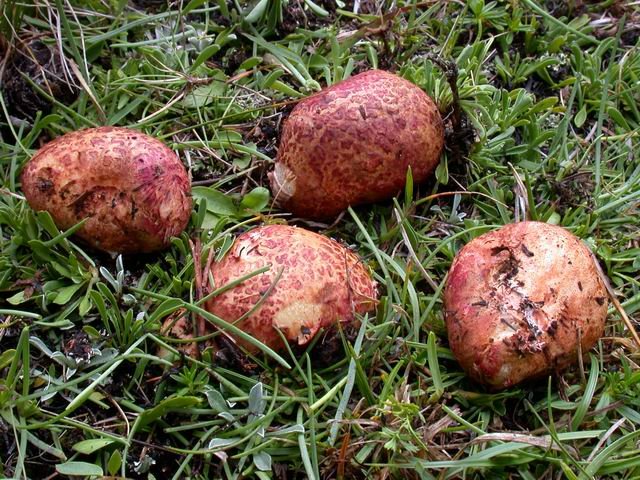
There are not so many mushrooms with underground fruiting bodies.Most of them are marsupial mushrooms (relatives of morels and lines), they are small in size and practically tasteless (before, by the way, they were used as aphrodisiacs); there are also quite a few underground raincoats, which are just as culinary nondescript. The only exception to the marsupials is the famous truffles, which are great in taste and quite large.
As for the cap mushrooms that have returned underground, there are only a few of them in our area. These are four types of so-called rhizomes, an underground russula, known as the underground russula Mattirolo (Elasmomyces mattirolianus), and a tiny spherical underground varnish. Kornevtsy resemble most of all a small rounded potato, the Mattirolo russula looks like a russula, the edges of the cap of which are attached to the leg. Both root roots and underground russula taste rather mediocre.
The other day, being at a dacha in Zagoryanka (the village of Zagoryansky, near Moscow), my eldest daughter made me happy with a rather rare find. In the “forest” part of the site, she dug up a large, luxurious specimen of pinkish rhizome.
According to her, she simply "lay in the leaves, and the mushroom itself climbed into the hand." I wish all the exotics would continue to do so.

There was a real giant, seven centimeters in diameter, almost a champion in size. Usually, fruiting bodies are 1-6 (up to  cm in diameter. They are tuberous, irregularly rounded.
cm in diameter. They are tuberous, irregularly rounded.
The outer surface is thin, white, later yellowish or olive-brown, reddening when touched, with single dark mycelial strands on the surface.
The inner spore-bearing part is fleshy, dense, white, turning pink at the cut, later (when ripe) yellowish, brownish-greenish, without any special taste or smell, with numerous narrow winding chambers filled with spores.
Spore powder lemon yellow.
The fungus is quite rare, grows shallow in the soil or on the soil surface in pine forests (forms mycorrhiza with two-spined pines), parks, wooded summer cottages, often in “nests” of 2-8 specimens, in July-November. Prefers loose, sandy, well-drained and at the same time well-moistened soils with a sufficient amount of humus.
References
- Fries, Elias Magnus (1817). Symbolae Gasteromycorum... Lundae: Ex officina Berlingiana.
- ^
- Martín, MP (1996). The Genus Rhizopogon in Europe... Barcelona, Spain: BCG. pp. 173 p. ISBN.
- ^
- Maser C, Maser Z (1988). Interactions among squirrels, mycorrhizal fungi, and coniferous forests in Oregon. Western North American Naturalist. 48 (3): 358–369.
- Izzo AD, Meyer M, Trappe JM, North M, Bruns TD (2005). "Hypogeous ectomycorrhizal fungal species on roots and in small mammal diet in a mixed conifer forest." Forest science. 51 (3): 243–254.
- ^
- ^
- ^
- ^
- Gans, Maya (2019). "Invariant Communities of Endophytic Nitrogen-fixing Bacteria Associated with a Non-photosynthetic Plant." ProQuest Dissertations Publishing.
- Kessel SL (1927). Soil organisms. The dependence of certain pine species on a biological soil factor ". Empire forestry journal. 6: 70–74.
- Steinfield D, Amaranthus M, Cazares E (2003). "Survival of Ponderosa pine (Pinus ponderosa Dougl. ex Laws) seedlings outplanted with Rhizopogon mycorrhizae inoculated with spores at the nursery ". Journal of Arboriculture. 29 (4): 4197–208.
- Trappe, M; Evans; Trappe, J (2007). Field guide to North American Truffles... Berkeley, CA: Ten Speed Press. pp. 136 p. ISBN 978-1580088626.
- ^
Mushroom wind
In addition to producing insane amounts of yeast, mushrooms can also induce wind.
In a way, a mushroom is like a fruit hanging from a tree. The cap of a mushroom is full of spores, like a fruit is full of seeds. However, unlike a tree, most of the fungus is hidden underground. The mycelium forms a network that connects the mushrooms on the surface.
Image copyright Thinkstock Image caption Mold is also a mushroom
Fungi need their spores to spread as far as possible; then the offspring will not compete with their "parents" for nutritional resources. At the same time, mushrooms cannot count on the help of animals in traveling long distances. They have to rely on themselves and use the available resources. The main one is water.
When it comes time to spray the spores, the mushrooms release water vapor, thus cooling the air around them. The air currents create a lift that can carry spores up to 10 centimeters in all directions.
Where pinkish rhizopogons grow
The mushroom rhizopogon is found under spruce and pine, in mixed forests, where oak predominates, less often under other deciduous species. It is located in groups shallow in the soil, covered with leaf or coniferous litter. Only a small part of mature specimens appears on the surface, and even then rarely. The mode of growth makes it difficult to harvest and determine the boundaries of the distribution of the population.
Fruiting for a long time, the collection begins in the middle of summer.In the middle lane, if autumn is warm with sufficient rainfall, the last specimens are found in mid-October. The main accumulation of reddening truffles is sought near pines and firs under a coniferous pillow.
Taxonomy and diversity
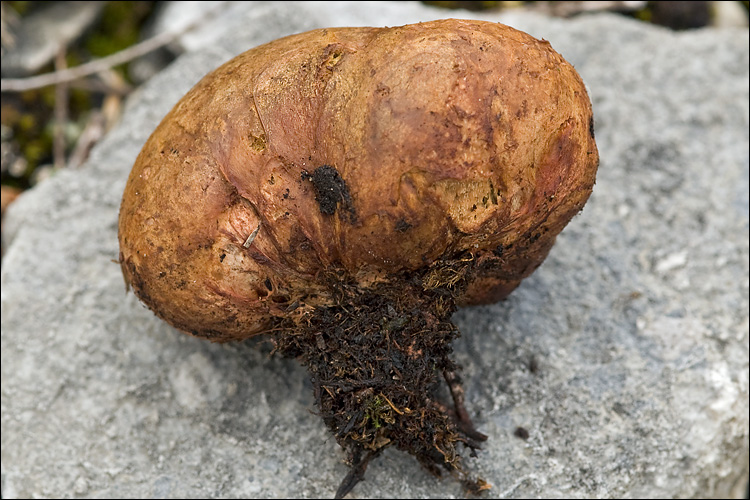
A sporocarp of Rhizopogon luteolus (= obtextus) showing rhizomorphs with adhering substrate
Historical classification
The genus Rhizopogon occurs throughout the natural and introduced ranges of family Pinaceae trees. Though this range covers much of the northern temperate zones, the diversity of Rhizopogon species is well characterized only in North America and Europe. There are currently over 150 recognized species of Rhizopogon... The morphology of Rhizopogon species is highly cryptic and characters vary greatly throughout sporocarp maturity. This has led to the description of multiple species from various developmental stages of a single fungus.
The genus Rhizopogon was first described from Europe by Elias Magnus Fries in 1817. The North American was produced by Alexander H. Smith in 1966 with second author credits given posthumously to Sanford Myron Zeller due to his contributions to the study of the genus. A European monograph of Rhizopogon has also been published. In the recent past, molecular phylogenetic methods have allowed the revision of the taxonomic concepts of the genus Rhizopogon
Modern classification
Modern taxonomic concepts of the genus Rhizopogon recognize five subgenera of Rhizopogon... These are subgenus Rhizopogon, subgenus Versicolores, subgenus Villosuli, subgenus Amylopogon, and subgenus Roseoli.
Rizopogon yellowish: what it looks like, where it grows, photo, is it possible to eat
Rhizopogon yellowish - a rare saprophyte mushroom, a relative of raincoats. Belongs to the class Agaricomycetes, family Rizopogonovye, genus Rizopogon. Another name for the mushroom is yellowish root, in Latin - Rhizopogon luteolus.
Where do yellowish rhizopogons grow
Rhizopogon luteolus is found throughout the temperate and northern latitudes of Eurasia. Grows in small groups mainly in pine forests on sandy and sub-sandy soils.
Forms mycorrhiza with conifers, most often with pines. It can be found in wooded summer cottages and parks. Loves loose soils with a high nitrogen content.
The fruiting body of the fungus is almost completely hidden underground or under a layer of fallen leaves, so it is not easy to find it.
What do yellowish rhizopogons look like?
Rhizopogon luteolus has a rather strange appearance for a fungus. He is missing a hat and a leg. The division of the fruiting body into upper and lower parts is rather arbitrary. Outwardly, it resembles a tuber of young potatoes. Has a size from 1 to 5 cm.
Young specimens are whitish-olive or light brown, mature ones are brown or brown. The surface of the fruiting body is dry. As it grows, its skin gradually cracks. The fruit body is entangled with gray-black filaments of the mycelium. Mature specimens have a pronounced garlic smell.
Spores are ellipsoidal, slightly asymmetric, shiny, smooth, transparent. The size of the spores is approximately 8 x 3 µm.
Taste qualities of the mushroom yellowish rhizopogon
Rhizopogon luteolus has a low taste. Despite the fact that it is considered edible.
Fried Rhizopogon tastes like a raincoat.
Benefits and harm to the body
Rhizopogon luteolus belongs to the fourth flavor category. The composition contains nutrients, but if used and prepared incorrectly, it is dangerous and can harm the body.
False doubles
Rhizopogon yellowish is similar in appearance to its relative - pinkish rhizopogon (Rhizopogon roseolus), another name for which is a blushing truffle or a turning pink truffle. This mushroom has a yellowish skin, if broken or cut, the flesh turns pink in this place.
The fruit body of a pinking truffle has a tuberous or irregularly rounded shape. Most of it is underground. The wall of the fruiting body is whitish or yellowish; when pressed, it becomes pinkish.
Rhizopogon pinkish edible, suitable for consumption only at a young age.
It is partially or completely hidden in the ground. The skin of a young mushroom is velvety; in a mature one, it becomes smooth and slightly cracks. Grows in spruce and pine forests, sometimes found in deciduous.
The harvesting season is from June to October. Never grows alone.
Rizopogon yellowish resembles dubious melanogaster (Melanogaster ambiguus). It is a very rare edible mushroom that grows singly in deciduous forests from May to October.
The pulp of the mushroom is purple-black, thick, fleshy, with a slight smell of garlic. Taste quality is low.
Collection rules
The harvesting season is from July to September. Rhizopogon luteolus is best harvested at the end of the season when it produces the highest yields.
Use
For eating, it is necessary to choose young specimens with a pleasant creamy pulp (old dark mushrooms cannot be used).
First, they must be rinsed under running water, carefully scrubbing each copy to remove the garlic taste and smell, then peel the thin skin.
Rhizopogon luteolus is prepared in the same way as raincoats, which are their closest relatives. All types of culinary processing are suitable for cooking - boiling, frying, stewing, baking, but they are most delicious when fried.
Attention! The mushroom can be dried, but only at a high temperature, otherwise it will germinate. Rhizopogon yellowish - a little-known species even among mushroom pickers
It is easy to confuse it with a white truffle, which is used by scammers selling it at a high price.
Rhizopogon yellowish - a little-known species even among mushroom pickers. It is easy to confuse it with a white truffle, which is used by scammers selling it at a high price.
Red Book view
Rhizopogon roseolus in the Red Data Book of the Chukotka Autonomous Okrug
Classification: Major Groups> Fungi, lichens and fungus-like organisms> Basidiomycota> Agaricomycetes> Boletales> Rhizopogonaceae> Rhizopogon
| Taxon | Rhizopogon roseolus (Rhizopogon pinkish) |
| Russian name | Rizopogon pinkish |
Legal status
| Document | Application | date | Taxon number | Specified as | Status | Category | Additionally |
|---|---|---|---|---|---|---|---|
| On approval of the list of rare and endangered plant species in the Chukotka Autonomous Okrug | 1 | 2008-04-24 | 5 | added |
Descriptions
| Edition | Chereshnev IA (otv ed), Berkutenko AN, Polezhaev AN, Kashin VA (2008) Red Data Book of the Chukotka Autonomous Okrug. Volume 2. Plants. Publishing house "Wild North" 217 p PDF External reference |
| The taxon is listed as | Rhizopogon roseolus |
| Category | 3: Rare species. |
| Morphological description | The fruit body is 2-5 cm in diameter, tuberous, irregularly rounded, oval, shapeless when coming to the surface, dirty-grayish, lighter in the ground, white or yellow-olive-brownish with brownish strands of mycelium. When touched and pressed, especially in the lower part, pink spots appear. On the cut, the "pulp" is spongy, multi-chambered, pink under the skin, then white, with age it becomes yellowish-olive. Fusiform, smooth, light yellow spores develop inside the chambers. |
| Spreading | Distributed throughout Russia, (European part. Caucasus, Far East (1), Baikal (oral communication), Magadan region (2), but everywhere rare. Found in the ChAO in the middle flow of the Anadyr river, HMS N region) -Eropol, lower river B. Kuibiveem (3). |
| Lifestyle | Mycorrhizal forming agent, enters into symbiosis with conifers. In Chukotka, it was recorded in mid-floodplain and high-floodplain communities with dwarf cedar in late July - August (2). The fruit body is underground, then comes to the surface. Edible at a young age. |
| Limiting factors | Not studied. |
| Security measures | Preservation of existing and search for new habitats of the species. |
| Links | 1. Sosin, 1973; 2. Sazanova, 2005; 3. Sazanova, 1993. |
| Compilers | ON. Sazanova |
The largest living organism on Earth is the mycelium
Finally, nothing living can match the size of mushrooms. In the US state of Oregon, there is a dark mushroom that extends over 10 square kilometers. Its age is from 1900 to 8650 years. However, despite its truly gigantic size, the mushroom was discovered only in the 21st century.
We see the mushrooms themselves only when the time for reproduction comes. If mushrooms were not sexually active, we might not even be aware of their existence.
Scientists were able to find out that mycelium mushrooms can reach such gigantic proportions only with the advent of DNA sequencing technology. After analyzing DNA samples from mushrooms in the area, scientists realized that all mushrooms are genetically identical.
Using the same method, researchers began to study colonies of microscopic fungi that live in soil and water, in plants and animals, and even in the air itself. The speed with which specialists are discovering all new types of fungi made them estimate the total number of these species on Earth at more than five million.
What other incredible feats are mushrooms that are not yet known to us?Systematics:
- Department: Basidiomycota (Basidiomycetes)
- Subdivision: Agaricomycotina
- Class: Agaricomycetes (Agaricomycetes)
- Subclass: Agaricomycetidae
- Order: Boletales
- Family: Rhizopogonaceae (Rhizopogonaceae)
- Genus: Rhizopogon
- View: Rhizopogon vulgaris (Rhizopogon common)
Other names for the mushroom:
Other names:
External description
The fruiting bodies of Rhizopogon vulgaris are tuberous or round (irregular) in shape. at the same time, only single strands of fungal mycelium can be seen on the surface of the soil, while the main part of the fruiting body develops underground. The diameter of the described fungus ranges from 1 to 5 cm. The surface of the common rhizopogon is characterized by a grayish-brown color. In ripe, old mushrooms, the color of the fruiting body may change, becoming olive-brown, with a yellowish tinge. In young mushrooms of common rhizopogon, the surface is velvety to the touch, and in old ones it becomes smooth. The inside of the mushroom is dense, oily and thick. At first, it has a light shade, but when mushroom spores mature, it becomes yellowish, sometimes brown-green.
The pulp of Rhizopogon vulgaris does not have any specific aroma and taste; it consists of a large number of special narrow chambers in which the spores of the fungus are located and mature. The lower region of the fruiting body contains small roots called rhizomorphs. They are white.
The spores of the fungus Rhizopogon vulgaris are characterized by an elliptical shape and a fusiform structure, smooth, with a yellowish tinge. A drop of oil can be seen along the edges of the spores.
Season and habitat of the mushroom
Common Rhizopogon (Rhizopogon vulgaris) is widespread in spruce, pine-oak and pine forests. You can also find this mushroom sometimes in deciduous or mixed forests. It grows mainly under conifers, pines and spruces. However, sometimes this type of mushroom can also be found under trees of other species (including deciduous ones). For its growth, Rhizopogon usually chooses soil or litter from fallen leaves. It is not found too often, it grows on the surface of the soil, but more often it is deeply buried inside it. Active fruiting and an increase in the yield of ordinary rhizopogon occurs during the period from June to October. It is almost impossible to see solitary mushrooms of this species, since Rhizopogon vulgaris grows only in small groups.
Edibility
Rhizopogon ordinary belongs to the poorly studied mushrooms, but it is considered edible. Mycologists recommend eating only the young fruiting bodies of Rhizopogon vulgaris.
Similar types and differences from them
Common Rhizopogon (Rhizopogon vulgaris) is very similar in appearance to another mushroom of the same genus, which bears the name. True, in the latter, with damage and strong pressure, the pulp turns red, and the color of the outer surface of the fruiting body is white (in mature mushrooms it becomes olive-brown or yellowish).
Rizopogon pinkish: how to cook, description and photo
| Name: | Rizopogon pinkish |
| Latin name: | Rhizopogon roseolus |
| Type of: | Conditionally edible |
| Synonyms: | Truffle turning pink, Truffle turning red |
| Specifications: |
|
| Systematics: |
|
Red truffle, pinkish rhizopogon, pinkish truffle, Rhizopogon roseolus - these are the names of the same mushroom of the genus Rizopogon. The fruiting body is formed shallowly under the topsoil. It is rare, not in demand among mushroom pickers.
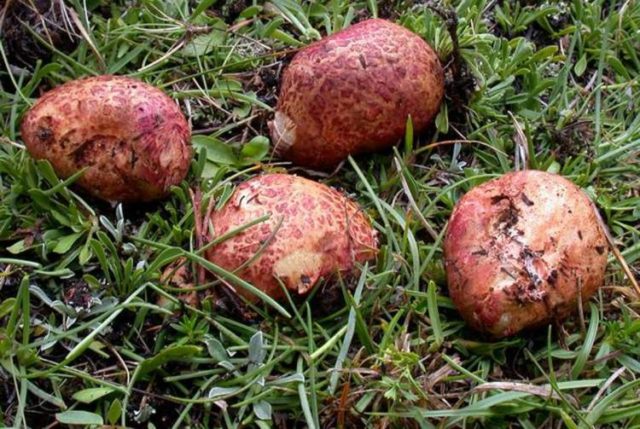
Where pinkish rhizopogons grow
The mushroom rhizopogon is found under spruce and pine, in mixed forests, where oak predominates, less often under other deciduous species. It is located in groups shallow in the soil, covered with leaf or coniferous litter.Only a small part of mature specimens appears on the surface, and even then rarely. The mode of growth makes it difficult to harvest and determine the boundaries of the distribution of the population.
Fruiting for a long time, the collection begins in the middle of summer. In the middle lane, if autumn is warm with sufficient rainfall, the last specimens are found in mid-October. The main accumulation of reddening truffles is sought near pines and firs under a coniferous pillow.
What pinkish rhizopogons look like
Rhizopogons are not divided into a leg and a cap. The fruit body is uneven, rounded or tuberous. They grow under the top layer of the soil, on the surface there are often only long filaments of mycelium.
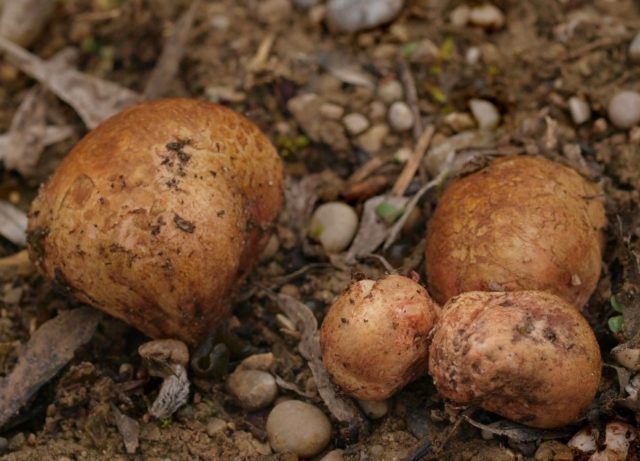
- The diameter of the fruiting body of an adult specimen is 5-6 cm.
- Peridium is first whitish, then yellow with a greenish tint.
- When pressed, the place turns red, the color also changes after being removed from the soil, the peridium oxidizes and turns pink, hence the specific name.
- The surface of young specimens is rough, velvety. Ripe mushrooms become smooth.
- The pulp is dense, oily, during ripening it changes color from white to light brown, turns red at the cut site. The inner part of the peridium consists of numerous longitudinal chambers filled with spores.
Is it possible to eat pinkish rhizopogons
The species is little known, it is not collected in large quantities. Belongs to the category of edible mushrooms. There are no substances poisonous to humans in the fruiting body. Rhizopogones are consumed only at a young age. Over time, the pulp becomes loose and dry.
Taste qualities of the mushroom pinkish rhizopogon
The mushroom is vaguely reminiscent of truffle in taste, a delicacy. The pulp is juicy, dense with a pleasant, sweetish taste, but only in young specimens. The smell is weak, barely perceptible. Peridia are used without preliminary processing.
False doubles
The most similar twin is the common Rhizopogon (Rhizopogon vulgaris).
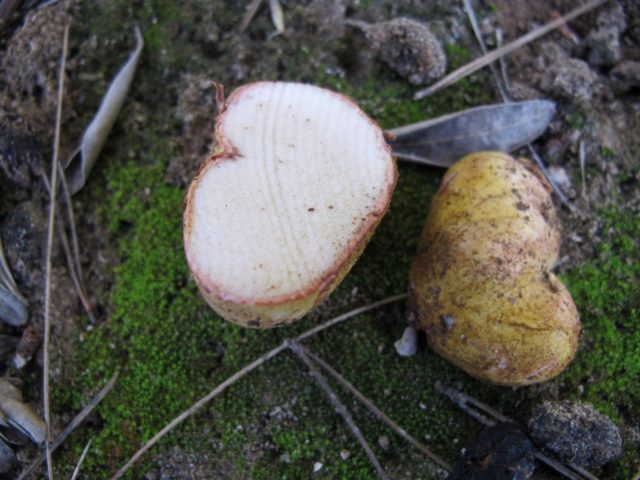
Outwardly, the fruit bodies of the twin in color and shape resemble potato tubers. The surface of the peridium is velvety, light olive in color. The flesh is creamy, dense and oily, darkens slightly on the cut, and does not turn reddish. The method, time and place of growth are the same for the species. A similar mushroom belongs to the fourth group in terms of nutritional value.
Use
The reddening truffle is used without preliminary soaking and boiling. The pulp is firm, with a pleasant taste, well suited for all processing methods. You can prepare the second and first courses from pinkish rhizopogon. Fruit bodies are suitable for pickling and pickling. Used as an ingredient in salads, you can make pate or mushroom caviar.
Conclusion
Rhizopogon pinkish - a rare mushroom with a mild smell and taste. Refers to the conditionally edible group. The fruiting body without a cap and a stem is rounded, completely in the ground. The main accumulation of rhizopogons near conifers.


